- Show search
Perspectives

The Science of Sustainability
Can a unified path for development and conservation lead to a better future?
October 13, 2018
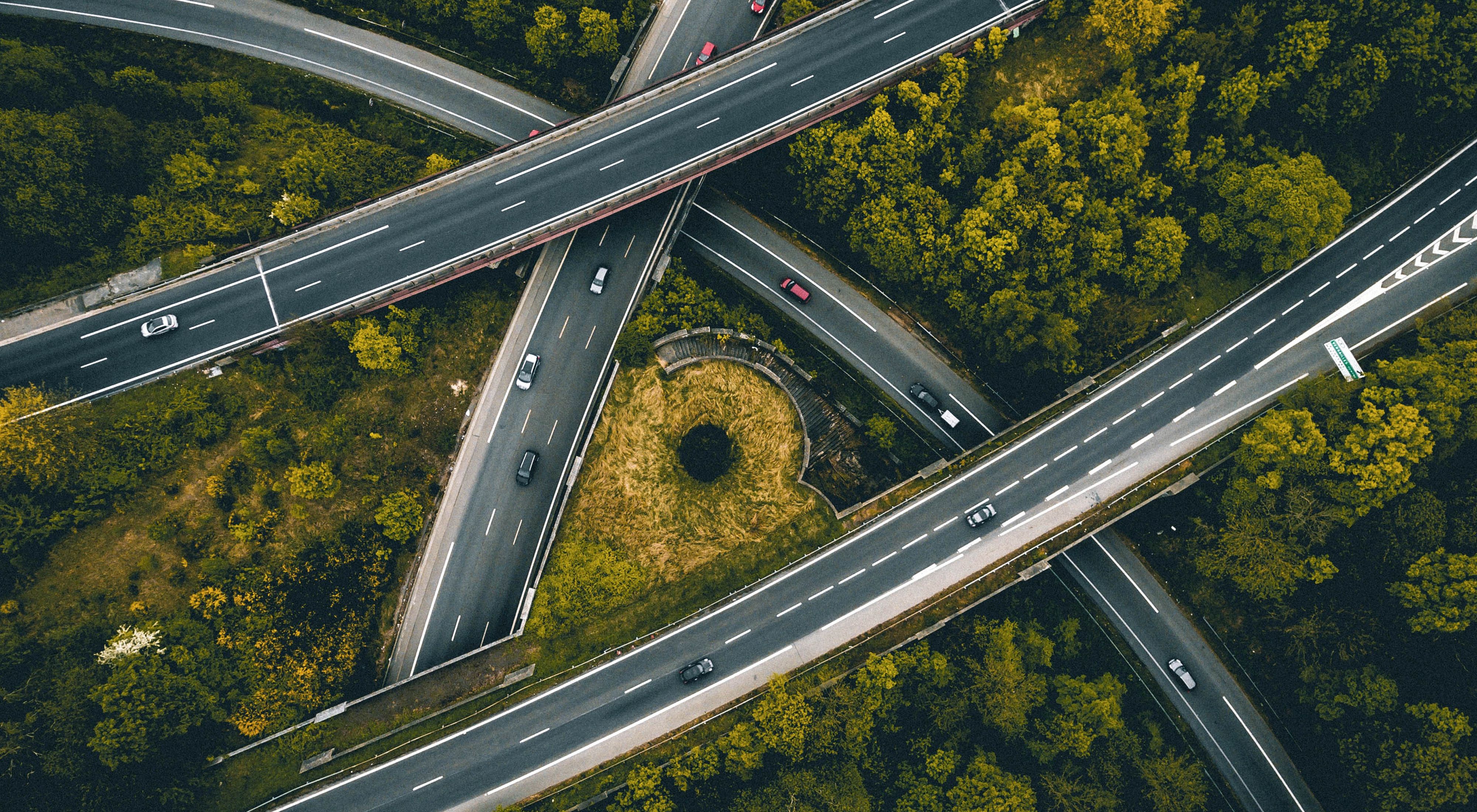
- A False Choice
- Two Paths to 2050
- What's Possible
- The Way Forward
- Engage With Us
The Cerrado may not have the same name recognition as the Amazon , but this vast tropical savannah in Brazil has much in common with that perhaps better-known destination. The Cerrado is also a global biodiversity hotspot, home to thousands of species only found there, and it is also a critical area in the fight against climate change, acting as a large carbon pool.
But Brazil is one of the two largest soy producers in the world—the crop is one of the country’s most important commodities and a staple in global food supplies—and that success is placing the Cerrado in precarious decline. To date, around 46% of the Cerrado has been deforested or converted for agriculture.
Producing more soy doesn’t have to mean converting more native habitat, however. A new spatial data tool is helping identify the best places to expand soy without further encroachment on the native landscapes of the Cerrado. And with traders and bankers working together to offer preferable financing to farmers who expand onto already-converted land, Brazil can continue to produce this important crop, while protecting native habitat and providing more financial stability for farmers.
The Cerrado is just one region of a vast planet, of course, but these recent efforts to protect it are representative of a new way of thinking about the relationship between conservation and our growing human demands. It is part of an emerging model for cross-sector collaboration that aims to create a world prepared for the sustainability challenges ahead.
Is this world possible? Here, we present a new science-based view that says “Yes”—but it will require new forms of collaboration across traditionally disconnected sectors, and on a near unprecedented scale.
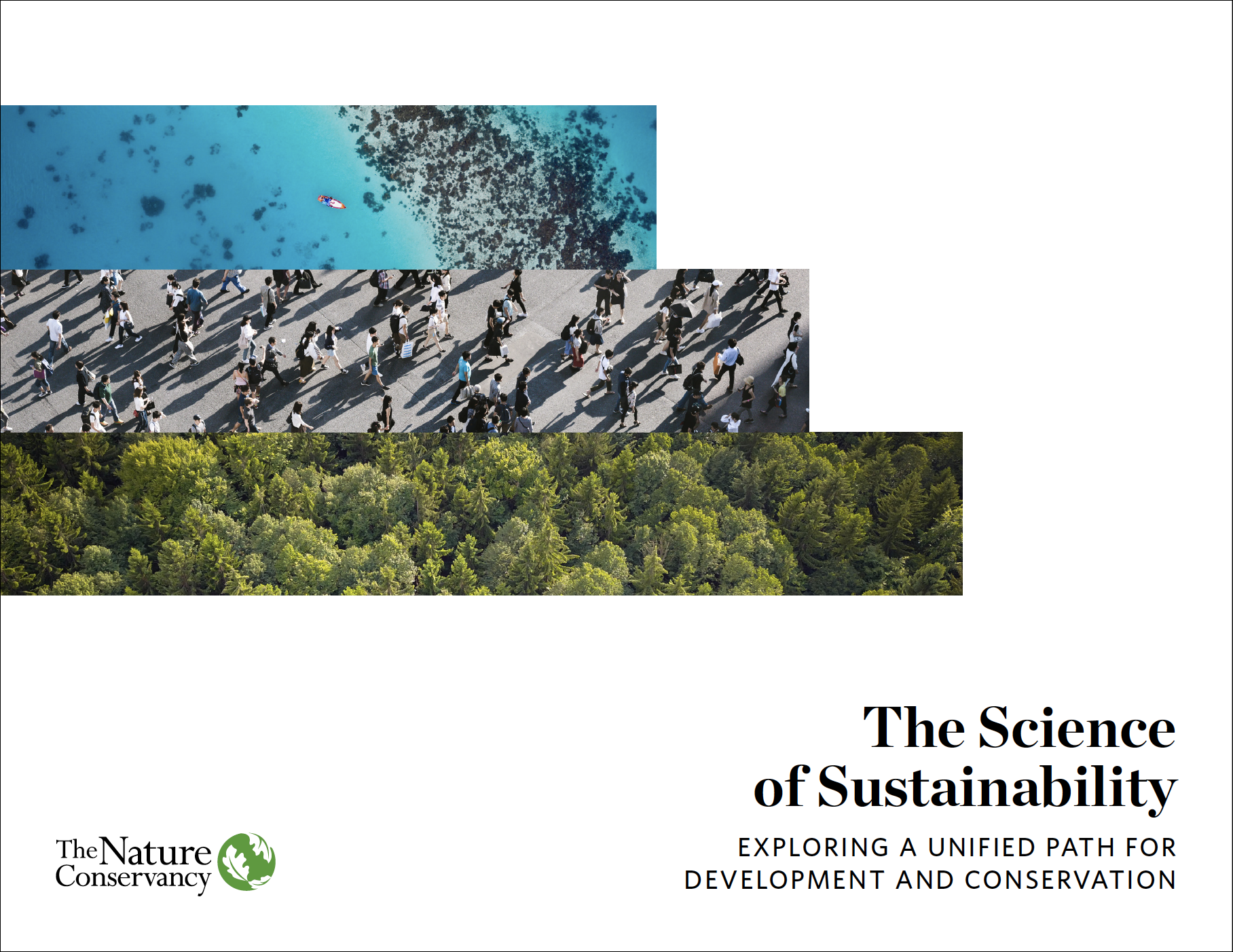
Download a PDF version of this feature. Click to see translated versions of this page.
I. A False Choice
Many assume that economic interests and environmental interests are in conflict. But new research makes the case that this perception of development vs. conservation is not just unnecessary but actively counterproductive to both ends. Achieving a sustainable future will be dependent on our ability to secure both thriving human communities and abundant and healthy natural ecosystems.
The Nature Conservancy partnered with the University of Minnesota and 11 other organizations to ask whether it is possible to achieve a future where the needs of both people and nature are advanced. Can we actually meet people’s needs for food, water and energy while doing more to protect nature?
The perception of development vs. conservation is not just unnecessary, but actively counterproductive to both ends.
To answer this question, we compared what the world will look like in 2050 if economic and human development progress in a “business-as-usual” fashion and what it would look like if instead we join forces to implement a “sustainable” path with a series of fair-minded and technologically viable solutions to the challenges that lie ahead.
In both options, we used leading projections of population growth and gross domestic product to estimate how demand for food, energy and water will evolve between 2010 and 2050. Under business-as-usual, we played out existing expectations and trends in how those changes will impact land use, water use, air quality, climate, protected habitat areas and ocean fisheries. In the more sustainable scenario, we proposed changes to how and where food and energy are produced, asking if these adjustments could result in better outcomes for the same elements of human well-being and nature. Our full findings are described in a peer-reviewed paper— “An Attainable Global Vision for Conservation and Human Well-Being” —published in Frontiers in Ecology and the Environment .
These scenarios let us ask, can we do better? Can we design a future that meets people’s needs without further degrading nature in the process?
Our answer is “yes,” but it comes with several big “ifs.” There is a path to get there, but matters are urgent—if we want to accomplish these goals by mid-century, we’ll have to dramatically ramp up our efforts now. The next decade is critical.
Furthermore, changing course in the next ten years will require global collaboration on a scale not seen perhaps since World War II. The widely held impression that economic and environmental goals are mutually exclusive has contributed to a lack of connection among key societal constituencies best equipped to solve interconnected problems—namely, the public health, development, financial and conservation communities. This has to change.
The good news is that protecting nature and providing water, food and energy to a growing world do not have to be either-or propositions. Our view, instead, calls for smart energy, water, air, health and ecosystem initiatives that balance the needs of economic growth and resource conservation equally. Rather than a zero-sum game, these elements are balanced sides of an equation, revealing the path to a future where people and nature thrive together.
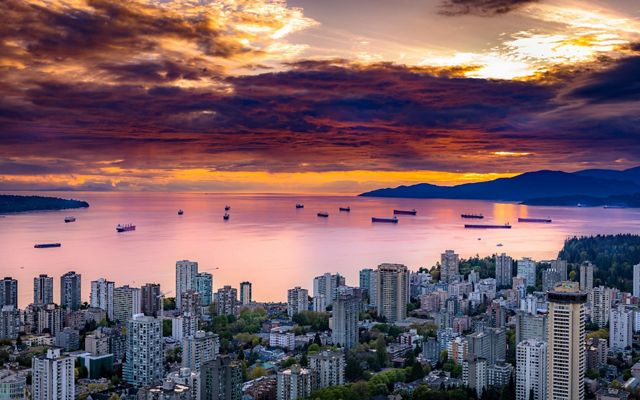
II. Two Paths to 2050
This vision is not a wholesale departure from what others have offered. A number of prominent scientists and organizations have put forward important and thoughtful views for a sustainable future; but often such plans consider the needs of people and nature in isolation from one another, use analyses confined to limited sectors or geographies, or assume that some hard tradeoffs must be made, such as slowing global population growth, taking a reduction in GDP growth or shifting diets off of meat. Our new research considers global economic development and conservation needs together, more holistically, in order to find a sustainable path forward.
What could a different future look like? We’ve used as our standard the United Nations’ Sustainable Development Goals (SDGs), a set of 17 measures for “a world where all people are fed, healthy, employed, educated, empowered and thriving, but not at the expense of other life on Earth.” Our analysis directly aligns with ten of those goals. Using the SDGs as our guideposts, we imagine a world in 2050 that looks very different than the one today—and drastically different from the one we will face if we continue in business-as-usual fashion.
A sustainable future is possible.
To create our assessment of business-as-usual versus a more sustainable path, we looked at 14 measurements including temperature change, carbon dioxide levels, air pollution, water consumption, food and energy footprints, and protected areas.
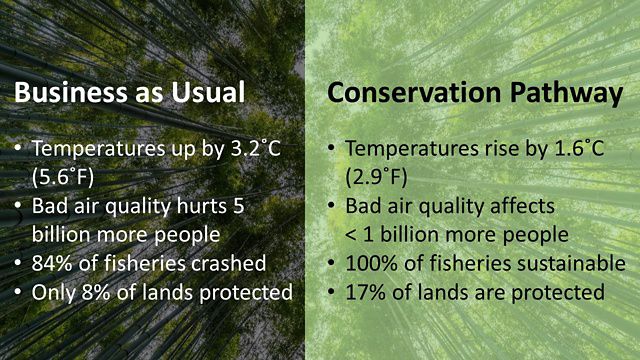
Over the next 30 years, we know we’ll face rapid population growth and greater pressures on our natural resources. The statistics are sobering—with 9.7 billion people on the planet by 2050, we can expect a 54 percent increase in global food demand and 56 percent increase in energy demand. While meetings these growing demands and achieving sustainability is possible, it is helpful to scrutinize where the status quo will get us.
The World Health Organization, World Economic Forum and other leading global development organizations now say that air pollution and water scarcity—environmental challenges—are among the biggest dangers to human health and prosperity. And our business-as-usual analysis makes clear what many already fear: that human development based on the same practices we use today will not prepare us for a world with nearly 10 billion people.
To put it simply, if we stay on today’s current path, we risk being trapped in an intensifying cycle of scarcity—our growth opportunities severely capped and our natural landscapes severely degraded. Under this business-as-usual scenario, we can expect global temperature to increase 3.2°C; worsened air pollution affecting 4.9 billion more people; overfishing of 84 percent of fish stocks; and greater water stress affecting 2.75 billion people. Habitat loss continues, leaving less than 50 percent of native grasslands and several types of forests intact.
However, if we make changes in where and how we meet food, water and energy demands for the same growing global population and wealth, the picture can look markedly different by mid-century. This “sustainability” path includes global temperature increase limited to 1.6°C—meeting Paris Climate Accord goals—zero overfishing with greater fisheries yields, a 90 percent drop in exposure to dangerous air pollution, and fewer water-stressed people, rivers and agricultural fields. These goals can be met while natural habitats extend both inside and outside protected areas. All signatory countries to the Aichi Targets meet habitat protection goals, and more than 50 percent of all ecoregions’ extents remain unconverted, except temperate grasslands (of which over 50 percent are already converted today).
Behind the Science
Discover how TNC and its partners developed the models for 2050.
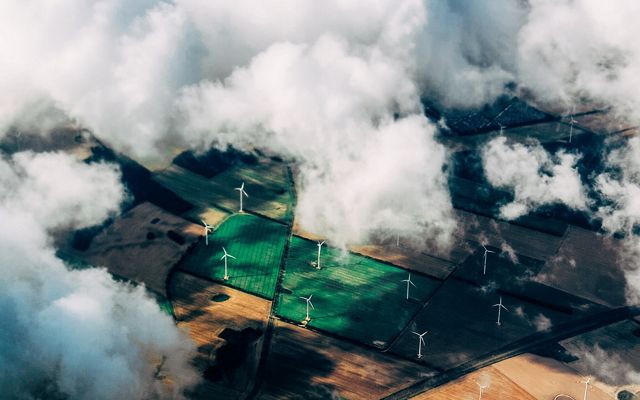
III. What's Possible
Achieving this sustainable future for people and nature is possible with existing and expected technology and consumption, but only with major shifts in production patterns. Making these shifts will require overcoming substantial economic, social and political challenges. In short, it is not likely that the biophysical limits of the planet will determine our future, but rather our willingness to think and act differently by putting economic development and the environment on equal footing as central parts of the same equation.
Climate, Energy and Air Quality
Perhaps the most pressing need for change is in energy use. In order to both meet increased energy demand and keep the climate within safe boundaries, we’ll need to alter the way we produce energy, curtailing emissions of carbon and other harmful chemicals.
Under a business-as-usual scenario, fossil fuels will still claim a 76 percent share of total energy in 2050. A more sustainable approach would reduce that share to 13 percent by 2050. While this is a sharp change, it is necessary to stanch the flow of harmful greenhouse gases into the atmosphere.
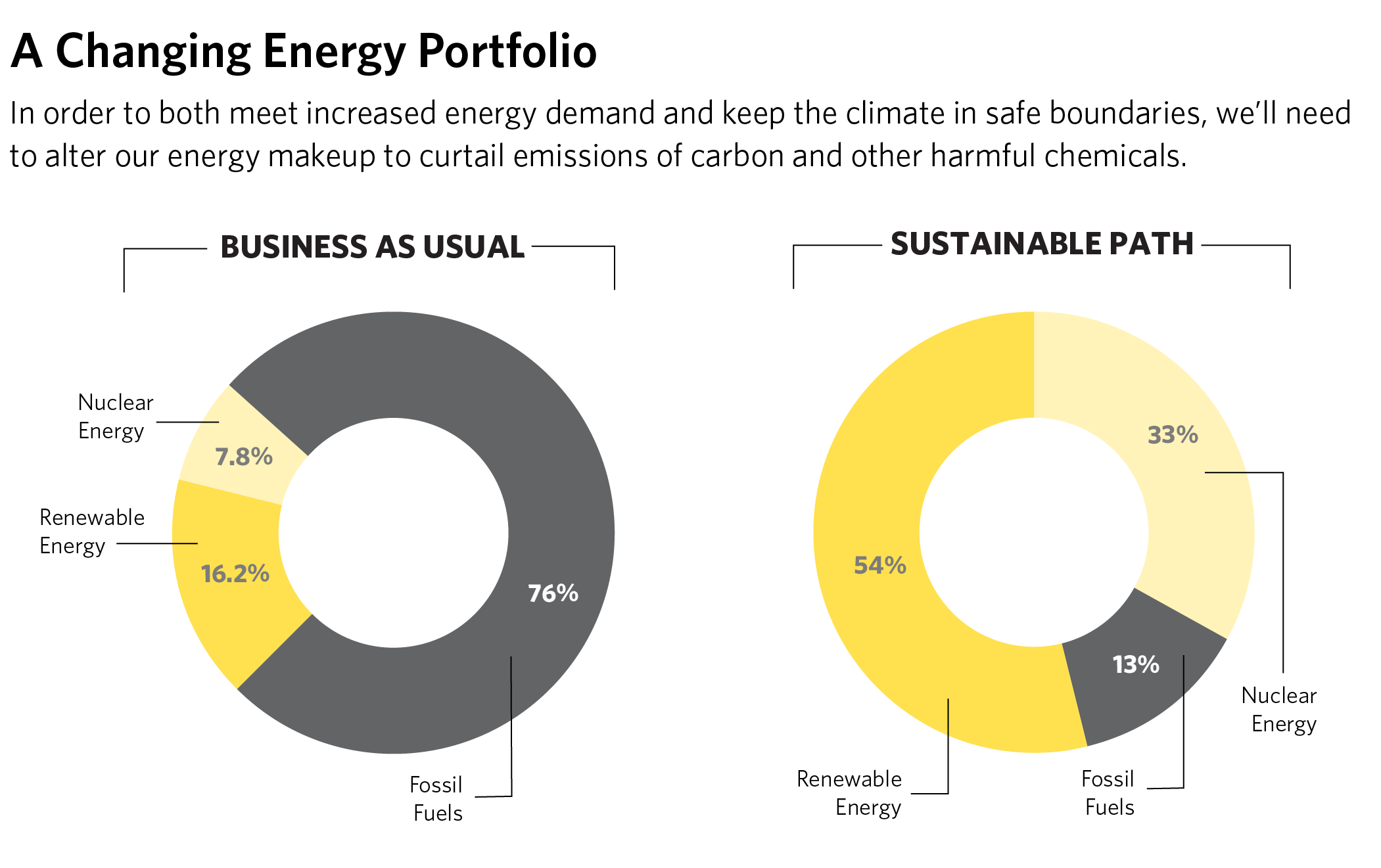
The reduction in carbon-based energy could be offset by increasing the share of energy from renewable sources to 54 percent and increasing nuclear energy to one third of total energy output—delivering a total of almost 85 percent of the world’s energy demand from non-fossil-fuel sources.
Additionally, we will only achieve the full extent of reduced climate impacts if we draw down existing carbon from the atmosphere. This can be done through greater investment in carbon capture and storage efforts, including natural climate solutions—land management strategies such as avoiding forest loss, reforestation, investments in soil health and coastal ecosystem restoration.
The net benefit of these energy redistribution efforts is twofold. First, they lower the rate at which greenhouse gases are flowing into the air—taking atmospheric carbon projections down to 442 parts per million, compared to business-as-usual estimates that put the level closer to 520 ppm.
Second, these energy source shifts would create a marked decline in particulate air pollution. Our models show that the higher fossil fuel use in the business-as-usual scenario is likely to expose half the people on the planet to poorer air quality by 2050. Under the sustainable scenario, that figure drops to just 7 percent of the world’s inhabitants, thanks to lower particulate emissions from renewable and nuclear energy sources.
Case Studies:
- Forests That Fight Climate Change: Brazil’s Serra da Mantiqueira region demonstrates how reforestation can tackle climate change, improve water supplies, and increase incomes in rural communities. Learn More
- Can Trees Be a Prescription for Urban Health?: Conservationists, community organizations and public health researchers joined forces to plant trees in Louisville, Kentucky and monitor their impact on air quality and residents’ health. Learn More
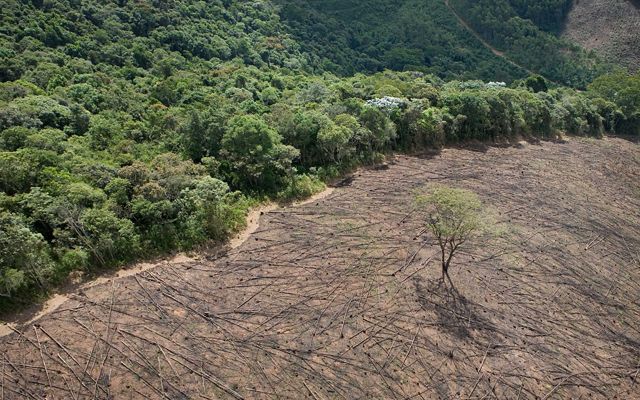
Food, Habitat and City Growth
Meeting the sustainable targets we propose requires a second front on land to shift how we use available real estate and where we choose to conduct necessary activities. Overall, the changes we include in our more sustainable view allow the world to meet global food, water and energy demands with no additional conversion of natural habitat for those needs—an outcome that is not possible under business as usual.
While transitioning away from fossil fuels is essential to meet climate goals, new renewable energy infrastructure siting will present land-use challenges. Renewable energy production takes up space, and if not sited well it can cause its own negative impacts on nature and its services to people. In our more sustainable path, we address this challenge by preferencing the use of already converted land for renewables development, lessening the impact of new wind and solar on natural habitat. We also exclude expansion of biofuels, as they are known to require extensive land area to produce, causing conflicts with natural habitat and food security.
Perhaps most encouraging, we show that it is possible to meet future food demands on less agricultural land than is used today. Notably, our scenario keeps the mix of crops in each growing region the same, so as not to disrupt farmers’ cultures, technologies, capacity or existing crop knowledge. Instead, we propose moving which crops are grown where within growing regions, putting more “thirsty” crops in areas with more water, and matching the nutrient needs of various crops to the soils available.
Unlike some projections used by others, for this scenario we left diet expectations alone, matching meat consumption with business-as-usual expectations. If we were able to reduce meat consumption, especially by middle- and high-income countries where nutritional needs are met, reducing future agricultural land, water and pollution footprints would be even easier.
Meanwhile, on the land protection front, our analysis is guided by the Convention on Biological Diversity, the leading global platform most countries have signed. Each signatory country has agreed to protect up to 17 percent of each habitat type within its borders. While many countries will fall short of this goal under business as usual, it can be achieved in our more sustainable option.

By making changes in food, water and energy use, we can better protect nearly all habitat types.
We acknowledge 17 percent is an imperfect number, and many believe more natural habitat is needed to allow the world’s biodiversity to thrive. Looking beyond protected areas, we see additional differences in the possible futures we face. Our more sustainable option retains 577 million hectares more natural habitat than business as usual, much of it outside of protected areas. Conservation has long focused on representation—it is not only important to conserve large areas, but to represent different kinds of habitat. Under business as usual, we will lose more than half of several major habitat types by mid-century, including temperate broadleaf and mixed forests, Mediterranean forest, and temperate grassland. Flooded and tropical grasslands approach this level of loss as well.
But with the proposed shifts in food, water and energy use, we can do better for nearly all habitats in our more sustainable scenario. The one exception is temperate grasslands, a biome that has already lost more than 50 percent of its global extent today. In all, the more sustainable scenario shows a future that would be largely compatible with emerging views that suggest protecting half of the world’s land system.
Case Study:
- Managing Sprawling Soy: A partnership between businesses and nonprofit groups in Brazil will help farmers plant soy in the areas where it is has the smallest impact on natural habitats. Learn More
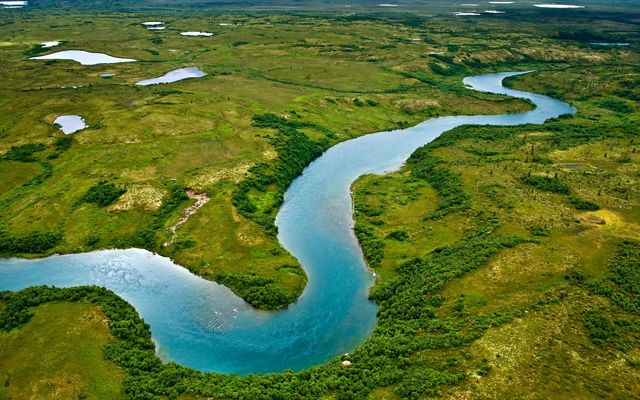
Drinking Water, River Basins and Fisheries
Water presents a complex set of challenges. Like land, it is both a resource and a habitat. Fresh water resources are dwindling while ocean ecosystems are overburdened by unregulated fishing and pollution. Business-as-usual projections estimate that 2.75 billion people will experience water scarcity by 2050 and 770 water basins will experience water stress. Africa and Central Asia in particular would see fewer water stressed basins in the sustainable scenario.
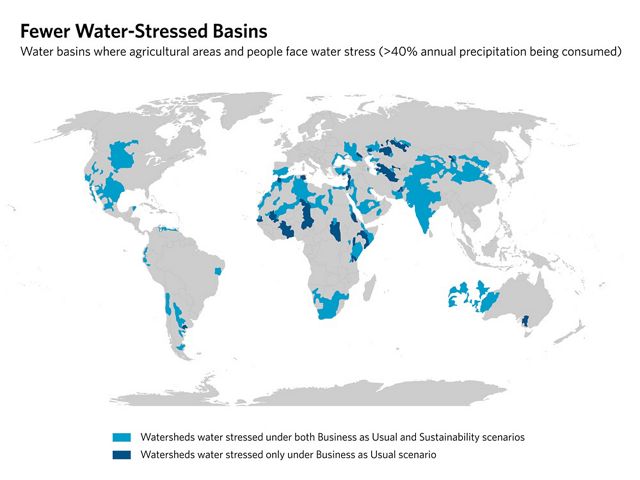
Changes in energy sources and food production (see above sections) would lead to significant water savings by reducing use of water as a coolant in energy production and by moving crops to areas where they need less irrigation. Thanks to these changes, our more sustainable option for the future would relieve 104 million people and biodiversity in 25 major river basins from likely water stress.
Meanwhile, in the seas, we find an inspiring possibility for fisheries. Continuing business-as-usual fisheries management adds further stress to the oceans and the global food system as more stocks decline, further diminishing the food we rely on from the seas. But more sustainable fisheries management is possible, and our projections using a leading fisheries model shows that adopting sustainable management in all fisheries by mid-century would actually increase yield by over a quarter more than we saw in 2010.
And, while we know that aquaculture is a certain element of the future of fish and food, many questions remain about precisely how this industry will grow, and how it can be shaped to be a low-impact part of the global food system. Given these unknowns, we kept aquaculture growth the same in both our views of the future.
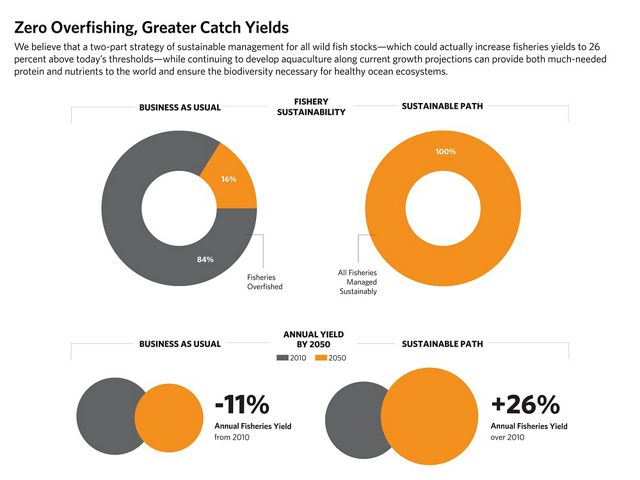
Case Studies:
- Cities and Farmers Find Common Ground on Water: Smarter agricultural practices in the Kenya’s Upper Tana River Watershed are resulting in better yields for farmers and more reliable water supplies for the city of Nairobi. Learn More
- Technology Offers a Lifeline for Fish: A new mobile application being piloted in Indonesia is helping fill a crucial gap in fisheries management—providing accurate data about what species are being caught where. Learn More

IV. The Way Forward
This analysis does not represent a panacea for the growing need for economic development across the planet or for the environmental challenges that are ahead. But it does provide an optimistic viewpoint and an integrated picture that can serve as a starting point for discussion.
Our goal is to apply new questions—and ultimately new solutions—to our known problems. We present one of many possible paths to a different future, and we welcome like-minded partners and productive critics to share their perspectives with us. We encourage people from across society to join the conversation, to fill gaps where they exist, and to bring other important considerations to our attention. Most of all, we call on the development (e.g. energy, agriculture, infrastructure), health, and financial communities—among others—to work with us to find new ways of taking action together.
Ultimately, by illustrating a viable pathway to sustainability that serves both the needs of economic and environmental interests—goals that many have long assumed were mutually exclusive—we hope to inspire the global community to engage in the difficult but necessary social, economic and political dialogue that can make a sustainable future a reality.
Protecting nature and providing water, food and energy to the world can no longer be either-or propositions. Nature and human development are both central factors in the same equation. We have at our disposal the cross-sector expertise necessary to make informed decisions for the good of life on our planet, so let’s use it wisely. Our science affirms there is a way.
Join us as we chart a new path to 2050 by helping people and nature thrive—together.
Testimonials

Opportunities to Engage
Designing strategies to address global challenges for people and nature requires integration of diverse bodies of evidence that are now largely segregated. As actors across the health, development and environment sectors pivot to act collectively, they face challenges in finding and interpreting evidence on sector interrelationships, and thus in developing effective evidence-based responses.
Learn more about these emerging coalitions that offer opportunities to engage and connect with shared resources.

Bridge Collaborative
The Bridge Collaborative unites people and organizations in health, development and the environment with the evidence and tools to tackle the world’s most pressing challenges. Learn More

Science for Nature and People Partnership
SNAPP envisions a world where protecting and promoting nature works in concert with sustainable development and improving human well-being. Learn More

Wicked Econ Fest
Wicked Econ Fests are workshops between leading economics, finance, conservation and policy experts to tackle specific, decision-driven challenges. Learn More

Global Insights
Check out our latest thinking and real-world solutions to some of the most complex challenges facing people and the planet today. Explore our Insights
10 bold ideas driving a sustainable future
From powering the planet with untapped clean energy to making climate action go viral, these 10 transformative ideas from the intersection of tech and sustainability are driving positive change — and building a greener future for generations to come. (Curated in partnership with Acura)
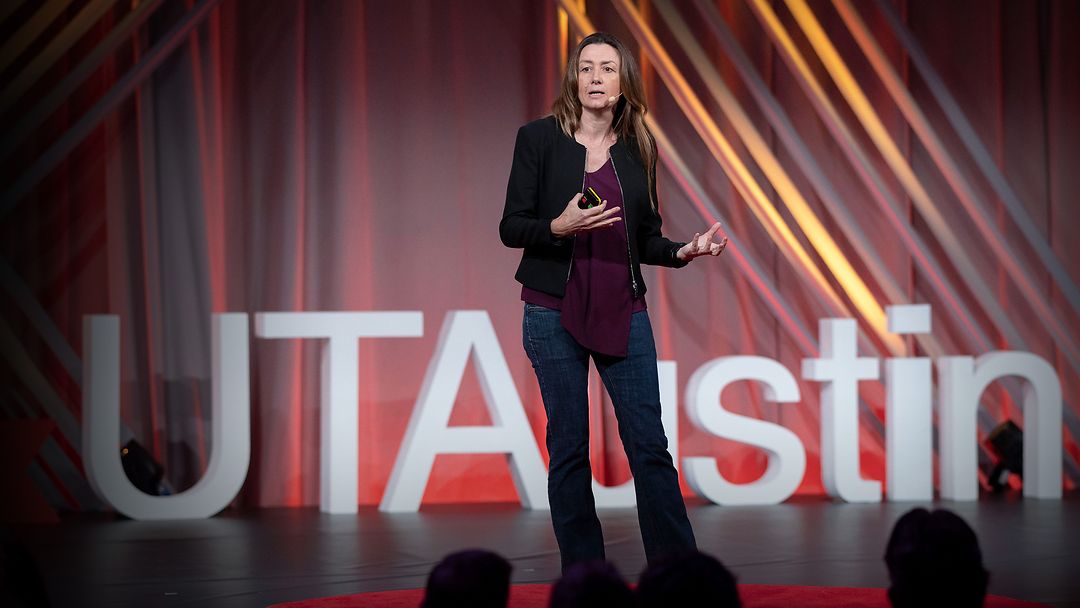
How "digital twins" could help us predict the future
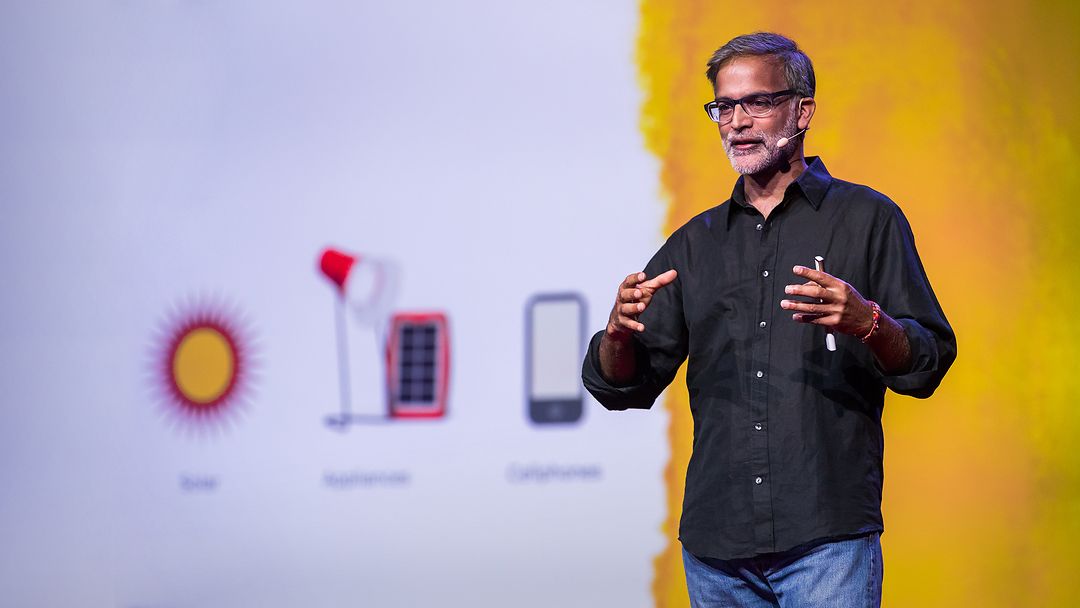
The thrilling potential for off-grid solar energy
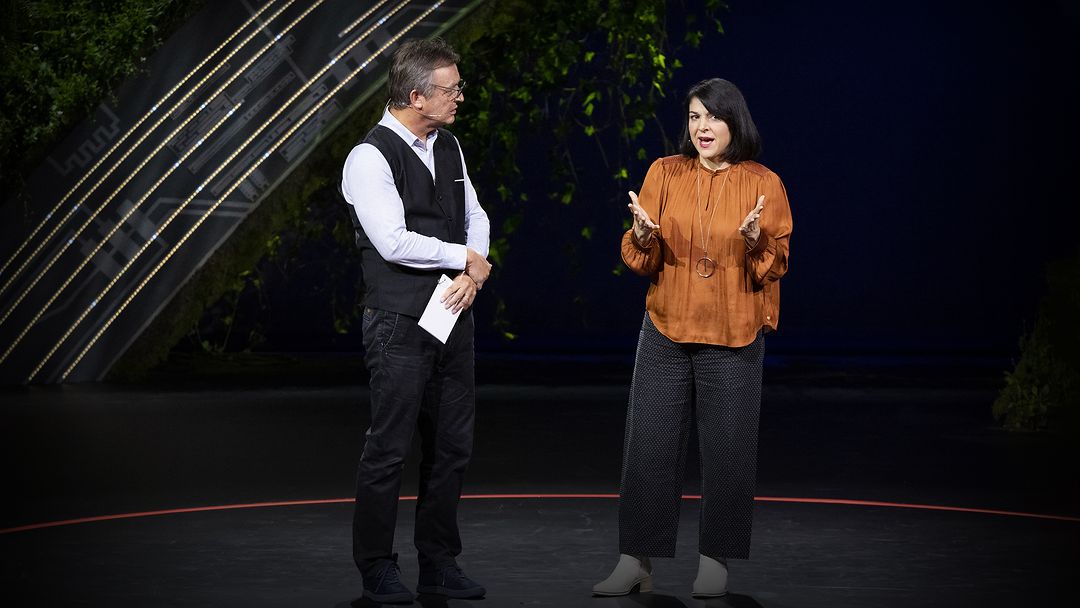
The billion-dollar campaign to electrify transport
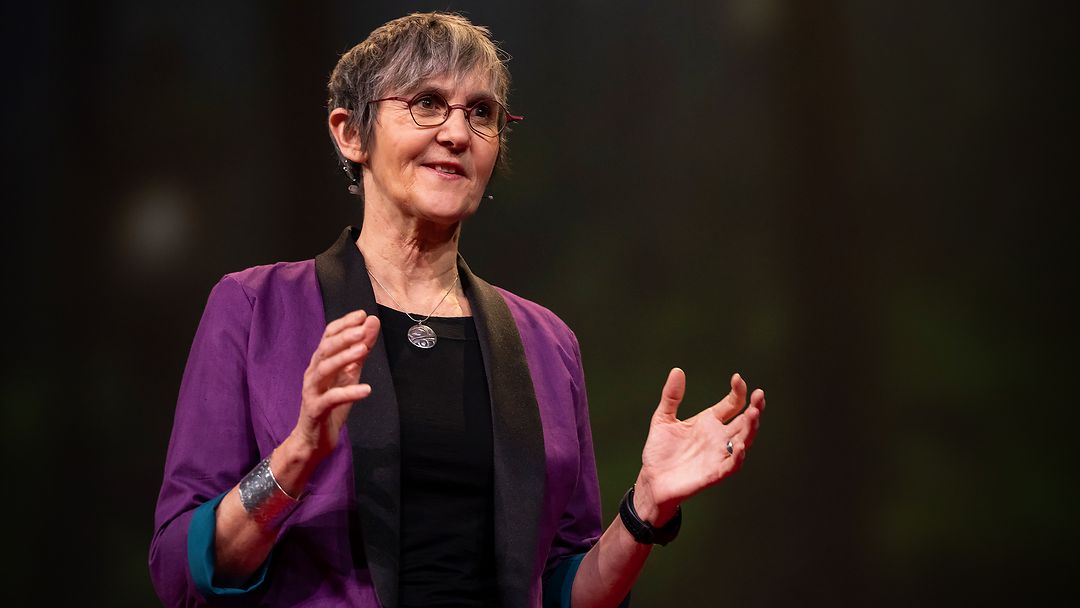
Why are we making pizza boxes out of endangered trees?
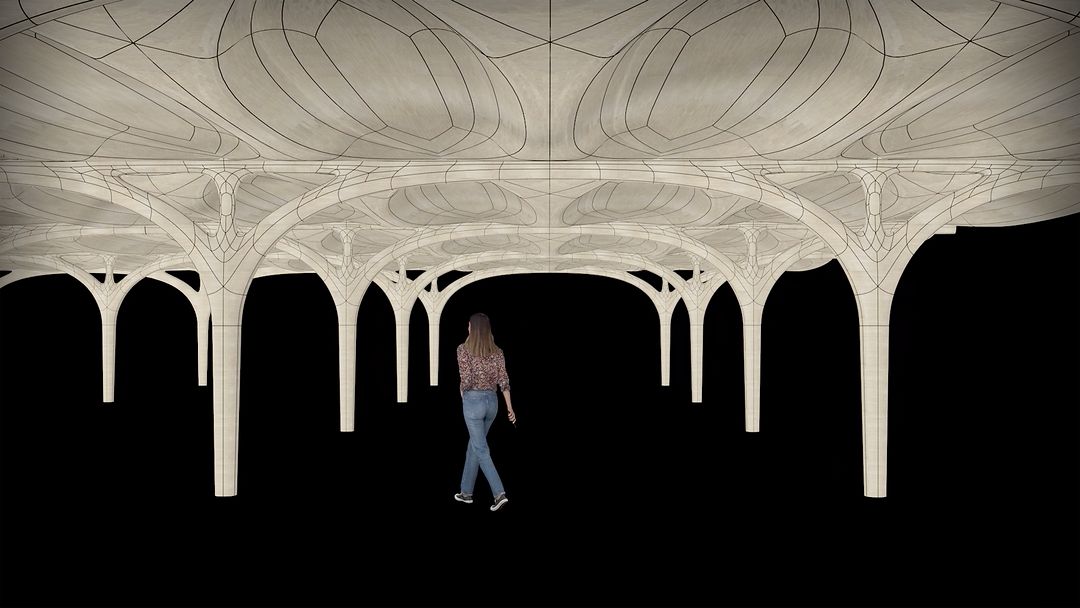
The natural building blocks of sustainable architecture
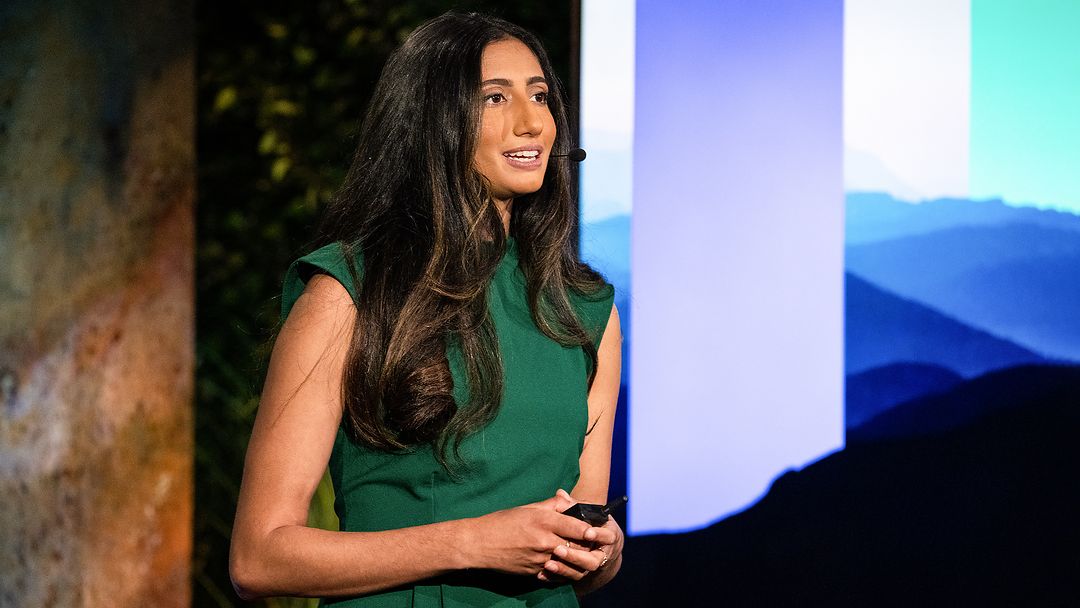
The eco-creators helping the climate through social media
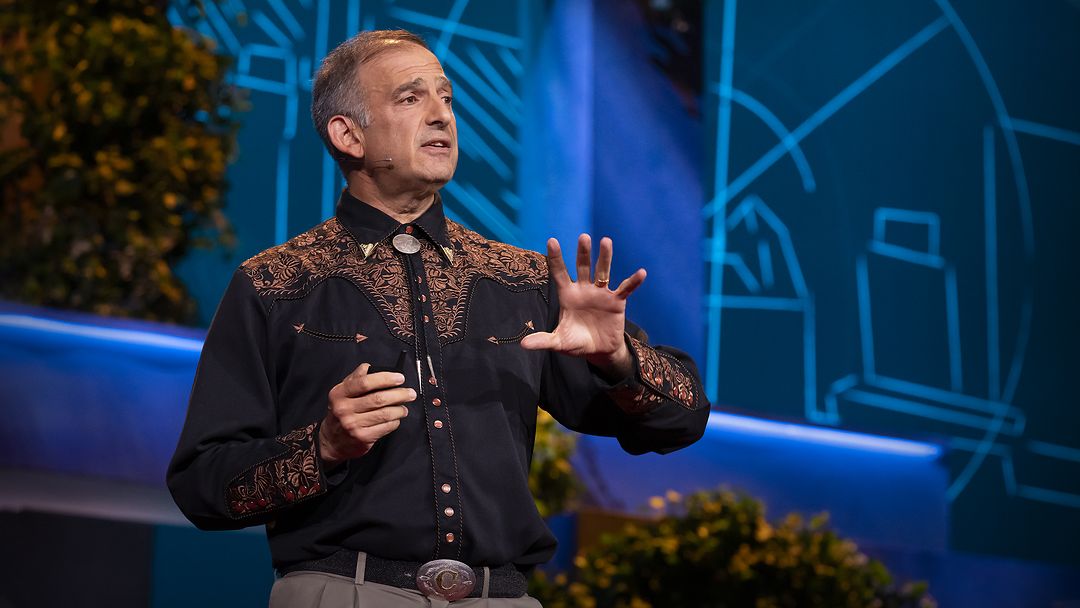
How to harness abundant, clean energy for 10 billion people
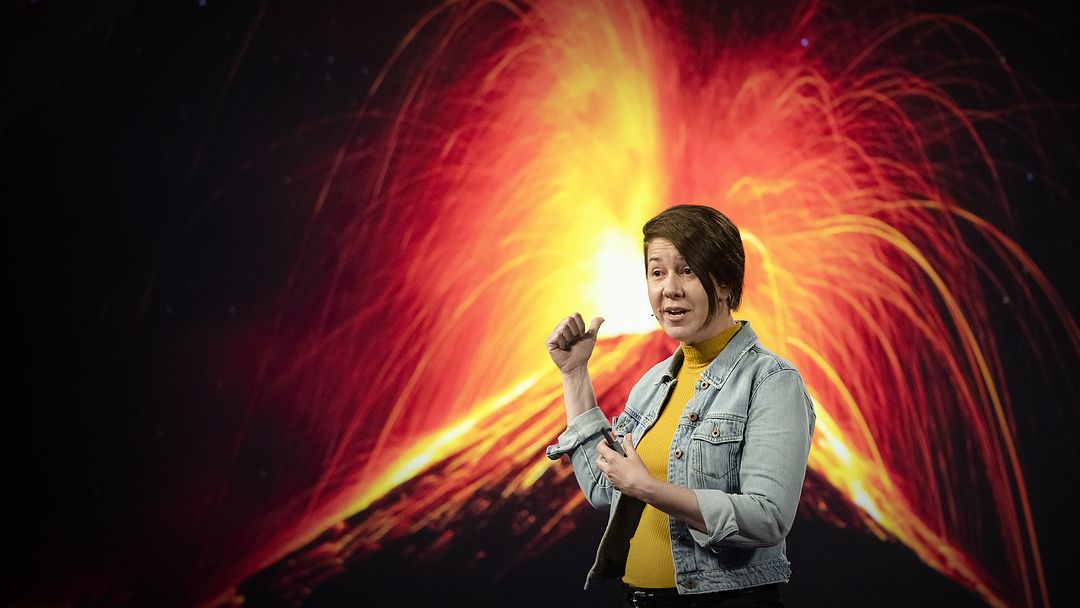
The untapped energy source that could power the planet

How to heat your home without hurting the planet
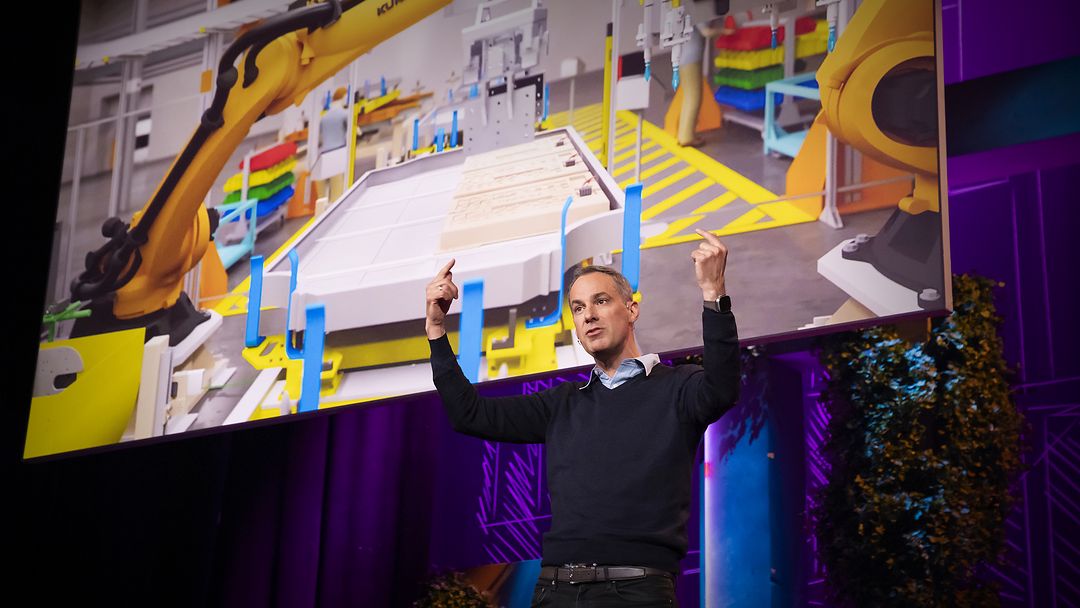
Time is running out on climate change. The metaverse could help

45,000+ students realised their study abroad dream with us. Take the first step today
Here’s your new year gift, one app for all your, study abroad needs, start your journey, track your progress, grow with the community and so much more.

Verification Code
An OTP has been sent to your registered mobile no. Please verify

Thanks for your comment !
Our team will review it before it's shown to our readers.

Essay on Sustainable Development: Samples in 250, 300 and 500 Words
- Updated on
- Nov 18, 2023
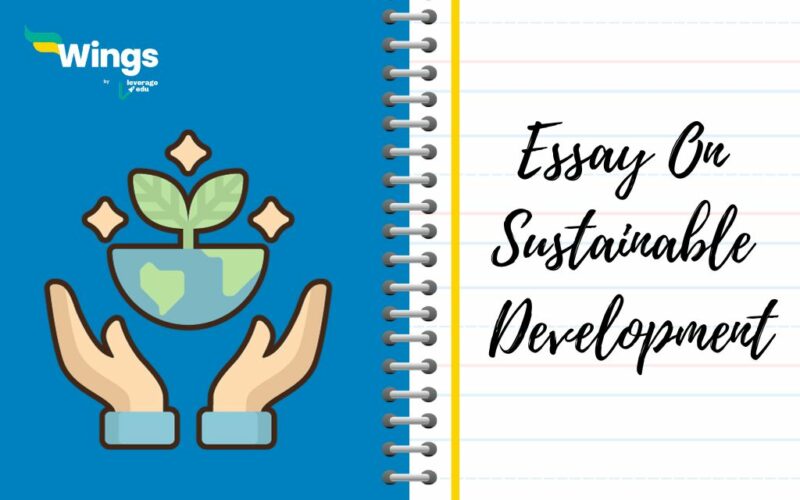
On 3rd August 2023, the Indian Government released its Net zero emissions target policy to reduce its carbon footprints. To achieve the sustainable development goals (SDG) , as specified by the UN, India is determined for its long-term low-carbon development strategy. Selfishly pursuing modernization, humans have frequently compromised with the requirements of a more sustainable environment.
As a result, the increased environmental depletion is evident with the prevalence of deforestation, pollution, greenhouse gases, climate change etc. To combat these challenges, the Ministry of Environment, Forest and Climate Change launched the National Clean Air Programme (NCAP) in 2019. The objective was to improve air quality in 131 cities in 24 States/UTs by engaging multiple stakeholders.
‘Development is not real until and unless it is sustainable development.’ – Ban Ki-Moon
Sustainable Development Goals, also known as SGDs, are a list of 17 goals to build a sustained and better tomorrow. These 17 SDGs are known as the ‘World’s Best Plan’ to eradicate property, tackle climate change, and empower people for global welfare.
This Blog Includes:
What is sustainable development, essay on sustainable development in 250 words, 300 words essay on sustainable development, 500 words essay on sustainable development, what are sdgs, introduction, conclusion of sustainable development essay, importance of sustainable development, examples of sustainable development.
As the term simply explains, Sustainable Development aims to bring a balance between meeting the requirements of what the present demands while not overlooking the needs of future generations. It acknowledges nature’s requirements along with the human’s aim to work towards the development of different aspects of the world. It aims to efficiently utilise resources while also meticulously planning the accomplishment of immediate as well as long-term goals for human beings, the planet as well and future generations. In the present time, the need for Sustainable Development is not only for the survival of mankind but also for its future protection.
To give you an idea of the way to deliver a well-written essay, we have curated a sample on sustainable development below, with 250 words:
To give you an idea of the way to deliver a well-written essay, we have curated a sample on sustainable development below, with 300+ words:

We all remember the historical @BTS_twt speech supporting #Youth2030 initiative to empower young people to use their voices for change. Tomorrow, #BTSARMY 💜 will be in NYC🗽again for the #SDGmoment at #UNGA76 Live 8AM EST welcome back #BTSARMY 👏🏾 pic.twitter.com/pUnBni48bq — The Sustainable Development Goals #SDG🫶 (@ConnectSDGs) September 19, 2021
To give you an idea of the way to deliver a well-written essay, we have curated a sample on sustainable development below, with 500 + words:

Sustainable Development Goals or SDGs are a list of 17 goals to build a better world for everyone. These goals are developed by the Department of Economic and Social Affairs of the United Nations. Let’s have a look at these sustainable development goals.
- Eradicate Poverty
- Zero Hunger
- Good Health and Well-being
- Quality Education
- Gender Equality
- Clean Water and Sanitation
- Affordable and Clean Energy
- Decent Work and Economic Growth
- Industry, Innovation, and Infrastructure
- Reduced Inequalities
- Sustainable Cities and Communities
- Responsible Consumption and Production
- Climate Action
- Life Below Water
- Life on Land
- Peace, Justice and Strong Institutions
- Partnership for the Goals
Essay Format
Before drafting an essay on Sustainable Development, students need to get familiarised with the format of essay writing, to know how to structure the essay on a given topic. Take a look at the following pointers which elaborate upon the format of a 300-350 word essay.
Introduction (50-60 words) In the introduction, students must introduce or provide an overview of the given topic, i.e. highlighting and adding recent instances and questions related to sustainable development. Body of Content (100-150 words) The area of the content after the introduction can be explained in detail about why sustainable development is important, its objectives and highlighting the efforts made by the government and various institutions towards it. Conclusion (30-40 words) In the essay on Sustainable Development, you must add a conclusion wrapping up the content in about 2-3 lines, either with an optimistic touch to it or just summarizing what has been talked about above.
How to write the introduction of a sustainable development essay? To begin with your essay on sustainable development, you must mention the following points:
- What is sustainable development?
- What does sustainable development focus on?
- Why is it useful for the environment?
How to write the conclusion of a sustainable development essay? To conclude your essay on sustainable development, mention why it has become the need of the hour. Wrap up all the key points you have mentioned in your essay and provide some important suggestions to implement sustainable development.
The importance of sustainable development is that it meets the needs of the present generations without compromising on the needs of the coming future generations. Sustainable development teaches us to use our resources correctly. Listed below are some points which tell us the importance of sustainable development.
- Focuses on Sustainable Agricultural Methods – Sustainable development is important because it takes care of the needs of future generations and makes sure that the increasing population does not put a burden on Mother Earth. It promotes agricultural techniques such as crop rotation and effective seeding techniques.
- Manages Stabilizing the Climate – We are facing the problem of climate change due to the excessive use of fossil fuels and the killing of the natural habitat of animals. Sustainable development plays a major role in preventing climate change by developing practices that are sustainable. It promotes reducing the use of fossil fuels which release greenhouse gases that destroy the atmosphere.
- Provides Important Human Needs – Sustainable development promotes the idea of saving for future generations and making sure that resources are allocated to everybody. It is based on the principle of developing an infrastructure that is can be sustained for a long period of time.
- Sustain Biodiversity – If the process of sustainable development is followed, the home and habitat of all other living animals will not be depleted. As sustainable development focuses on preserving the ecosystem it automatically helps in sustaining and preserving biodiversity.
- Financial Stability – As sustainable development promises steady development the economies of countries can become stronger by using renewable sources of energy as compared to using fossil fuels, of which there is only a particular amount on our planet.
Mentioned below are some important examples of sustainable development. Have a look:
- Wind Energy – Wind energy is an easily available resource. It is also a free resource. It is a renewable source of energy and the energy which can be produced by harnessing the power of wind will be beneficial for everyone. Windmills can produce energy which can be used to our benefit. It can be a helpful source of reducing the cost of grid power and is a fine example of sustainable development.
- Solar Energy – Solar energy is also a source of energy which is readily available and there is no limit to it. Solar energy is being used to replace and do many things which were first being done by using non-renewable sources of energy. Solar water heaters are a good example. It is cost-effective and sustainable at the same time.
- Crop Rotation – To increase the potential of growth of gardening land, crop rotation is an ideal and sustainable way. It is rid of any chemicals and reduces the chances of disease in the soil. This form of sustainable development is beneficial to both commercial farmers and home gardeners.
- Efficient Water Fixtures – The installation of hand and head showers in our toilets which are efficient and do not waste or leak water is a method of conserving water. Water is essential for us and conserving every drop is important. Spending less time under the shower is also a way of sustainable development and conserving water.
- Sustainable Forestry – This is an amazing way of sustainable development where the timber trees that are cut by factories are replaced by another tree. A new tree is planted in place of the one which was cut down. This way, soil erosion is prevented and we have hope of having a better, greener future.
Related Articles
The Sustainable Development Goals (SDGs) are a set of 17 global goals established by the United Nations in 2015. These include: No Poverty Zero Hunger Good Health and Well-being Quality Education Gender Equality Clean Water and Sanitation Affordable and Clean Energy Decent Work and Economic Growth Industry, Innovation, and Infrastructure Reduced Inequality Sustainable Cities and Communities Responsible Consumption and Production Climate Action Life Below Water Life on Land Peace, Justice, and Strong Institutions Partnerships for the Goals
The SDGs are designed to address a wide range of global challenges, such as eradicating extreme poverty globally, achieving food security, focusing on promoting good health and well-being, inclusive and equitable quality education, etc.
India is ranked #111 in the Sustainable Development Goal Index 2023 with a score of 63.45.
Hence, we hope that this blog helped you understand the key features of an essay on sustainable development. If you are interested in Environmental studies and planning to pursue sustainable tourism courses , take the assistance of Leverage Edu ’s AI-based tool to browse through a plethora of programs available in this specialised field across the globe and find the best course and university combination that fits your interests, preferences and aspirations. Call us immediately at 1800 57 2000 for a free 30-minute counselling session
Team Leverage Edu
Leave a Reply Cancel reply
Save my name, email, and website in this browser for the next time I comment.
Contact no. *
Thanks a lot for this important essay.
NICELY AND WRITTEN WITH CLARITY TO CONCEIVE THE CONCEPTS BEHIND SUSTAINABLE DEVELOPMENT IN SCIENCE AND TECHNOLOGY.
Thankyou so much!

Leaving already?
8 Universities with higher ROI than IITs and IIMs
Grab this one-time opportunity to download this ebook
Connect With Us
45,000+ students realised their study abroad dream with us. take the first step today..

Resend OTP in

Need help with?
Study abroad.
UK, Canada, US & More
IELTS, GRE, GMAT & More
Scholarship, Loans & Forex
Country Preference
New Zealand
Which English test are you planning to take?
Which academic test are you planning to take.
Not Sure yet
When are you planning to take the exam?
Already booked my exam slot
Within 2 Months
Want to learn about the test
Which Degree do you wish to pursue?
When do you want to start studying abroad.
September 2024
January 2025
What is your budget to study abroad?

How would you describe this article ?
Please rate this article
We would like to hear more.
- SCIENCE & TECHNOLOGY
- DEVELOPMENT & SOCIETY
- PEACE & SECURITY
- HUMANITARIAN AFFAIRS
- HUMAN RIGHTS
The Simpler Way to a Greener Future

I have been thinking a lot over the past few years about what I can do to reduce my ecological footprint. It is really not acceptable to ask others to make behavioural changes in order to improve the environment unless we are prepared to make them ourselves.
This became very clear to me in classes that I teach here at the UN University, where we have begun to ask the students and fellow lecturers to measure and share carbon footprints. The students are from all over the Asia Pacific region (and we connect via video conferencing , not by flying students or lecturers around) and the variation in footprints is quite considerable. Those living in industrialised countries tend to have considerably larger footprints than their colleagues from the industrializing world. The biggest factor is of course air travel and it is usually the lecturers, myself included, who are travelling most, either for research or to present at conferences.
During the course, we used an online carbon footprint calculator and it turns out that my footprint last year was 8.8 metric tons (a 29% drop on the previous year) and just below the average for Japan of 9.8 tons but twice that of the world average at 4 metric tons. So, I have a lot of scope for improvement.
Inspired by Colin Beavan we also run something called “No Impact Week” during the semester, whereby each of us tries to make changes to reduce our environmental impact. This could involve simple changes like having a zero waste day or an avoid shopping day. It is completely voluntary — you are not going to pass or fail — but also really enlightening.
In the student evaluation of the course we ask if there were “incidents, lectures or events during the class” that they enjoyed. Invariably, a large number of students write down how much they enjoy the carbon footprint measurements and No Impact Week. Said one of the students about these assignments:
“The first one, it was surprise to learn how much energy I consume. This activity greatly influenced me to change some of my behaviors to reduce energy consumption. The second one, it was good to see myself and other people seriously try to reduce the impacts of our behavior to the environment, even it is a short period, but it was a good start point.”
Personally speaking, just implementing these activities each year on the course got me to reduce my air travel (and subsequently lose my frequent flyer card), switch to a Prius, buy a bicycle and improve my diet — less meat, more fruit and vegetables. My colleagues at our partner universities who come back each year to teach also share stories of some of the changes they have made reducing travel, and with one even installing a solar photovoltaic system that gets her household down to a net-zero electricity bill.
Trapped between optimism and pessimism
While these can have a measurable, positive impact, such choices can be described as feel-good changes and they mainly happening in and around the class. I have to confess that for the remainder of the year, large parts of my daily life remain unchanged. I tend to think of myself as an optimistic person and that world is constantly getting better. Yet, when I read a lot about climate change, resource depletion, food security, biodiversity loss, water scarcity and so on, then I become more pessimistic and I know that feel-good changes are unlikely to be enough. It’s a conundrum. How do we make the world a better place and overcome major challenges like peak oil and climate change, for instance?
Two influential commentators, Ted Nordhaus and Michael Schellenberger, reflect one side of this conundrum in their 2004 essay entitled “The Death of Environmentalism” . They argue that we won’t solve big issues like global warming through behavioural changes. Instead they optimistically propose that the “solution to the ecological crises wrought by modernity, technology, and progress will be more modernity, technology, and progress.”
It is a view that is commonly held, something that was dubbed “Prometheanism” by John Dryzek in his 1997 book on The Politics of the Earth. The problem we encounter here, however, is that it may inadvertently suggest that we sit back and watch as business as usual plays out. The idea of doing nothing as individuals is attractive because it resonates with people who have a more relaxed and comfortable world-view.
But if you are of a more skeptical nature and prone towards pessimistic concern over pressing global issues, then you may view the contemporary state of the world as indicative of the need to transition towards some kind of new operating system. And if this transition is to succeed changes in our behavior will be required. Sure, technology may be part of the answer and progress on that front is key. But as others ( like author and sustainable development expert Tim Jackson ) have argued convincingly, the key may be to redefine what we mean by progress and prosperity.
And if, as physicist and human systems ecologist David Korowicz suggests , we actually are at a tipping point where we have to do more with less and less each year or face dire consequences, then sustaining our current behavioural patterns hardly seems to make much sense. The challenge here is that if you are acting when others are not you can easily be labeled as a “green, lefty, activist type”. It is just another way we humans find to be dismissive of the need, and doubt our own will power, to make changes.
Could the simple solution be best?
In this context, I am intrigued by a new initiative called The Simpler Way put together by Samuel Alexander, Ted Trainer and Simon Ussher of the Simplicity Institute . They have shared a practical action plan for living better on less. They present a range of areas where I can make changes in my life with five or six practical suggestions for each. The areas covered include clothing, energy, food, housing, money, technology, waste, transport, water, work and time, community, activism, politics, mindfulness and attitude. A lot of these suggestions are not new, but they are brought together neatly in one package.
One thing the authors of the action plan suggest is that “although there are hundreds of practical ideas in the first part of this document, each idea requires creative interpretation and personal application. This document, be sure, cannot replace thinking creatively for yourself”.
Ok, so I need to think creatively and I need to look to simplify my way of life. So, under “work and time” there are suggestions such as “consider reducing working hours”, “work from home one day per week,” and “telecommute instead of travelling”.
Well, I know that the UN has a policy on work–life balance that goes back to 2003 when Kofi Annan was the Secretary General. Now, what it would take to actualize this? A survey of UN staff in 2011 showed that only a small number of staff (43%) were aware of the possibility of “flexible working arrangements” and from that group and even smaller percentage had actually requested telecommuting (18%), staggered working hours (10%), compressed work schedules (9%), and scheduled breaks for external learning activity (3%). This exemplifies two common problems associated with bringing about positive changes — people have to be aware of what is possible and then go further to actually try it.
For travel, the Australia-based Simplicity Institute suggests I buy a bicycle (which I have done), use public transport as much as possible (which is easy and convenient in Tokyo), consider going car free (I still drive occasionally) and try not to fly so much (which I also have tried to practice). If I do have to fly, then I should look into paying a little extra for a carbon offset, at the very least.
Interestingly, carbon offsetting has been something we have talked about here at the UN University under our ISO14000 environmental management system, but we are still at the talking stage. I should also point out that being “ carbon neutral ” is a central goal of the entire UN system. That is a very progressive approach and something that needs to be pursued more extensively within the entire UN (i.e., everyone needs to be aware of and practice it).
The suggestions on food from The Simpler Way include growing “as much of your own as possible”, “use a community garden”, “support your local farmers market”, “reduce meat, dairy and fish consumption”, “consider vegetarianism” and “learn how to bake your own bread and preserve food.”
Well, living in Tokyo, we don’t have much space to grow things. In the past my family has grown peppers and tomatoes on our small veranda, and so maybe it is time to get back to doing that. We have thought about joining a community garden (and some colleagues at work have already done so ) but again this is something we need to look into doing and fitting into our busy schedules.
I already mentioned that I eat better now, consuming less meat than before. I bake bread occasionally, but I have never tried preserving food. Still, we have a wonderful farmers market on the UNU campus every weekend where it is possible to buy local agricultural produce. It is really interesting to see that, even in busy Tokyo, I am part of the way there in the move toward a more simple life.
Small steps add up
But the list of The Simpler Way suggestions is impressively long and I am going to need more time to look at what changes are possible and realistic over what timeframes. But The Simpler Way team suggest that I introduce changes gradually, not overnight, and continuously. I guess it is like dieting, if you reduce your weight too quickly, you may suffer from the rebound effect. If you try to simplify things too quickly you may suffer frustrations or give up. I can see, however, that a lot of people are already giving feedback on their experiences directly on The Simpler Way website and perhaps I can learn something there.
For some people, the suggestions may appear too mundane or paternalistic. For instance, under the money section we are advised to “live beneath your means” and “avoid debt”. Well, I do both, but that is a lot harder for many people and I wonder how they feel when reading these suggestions. Is the reaction “yeah, yeah, I would if I could!” or “Hmm, right! How did I let my spending get so out of control?”
The authors suggest that The Simpler Way “represents a life with less clutter, less waste, and less fossil fuel use, but also a life with more time for the things that truly inspire and bring happiness”. I would like to think that was true. But is it? Well, I won’t know if I don’t try!
It is interesting that last summer, after the earthquake and nuclear accident, everyone in the Tokyo region was told that due to the shortfall in electricity we would need to reduce our consumption by 15%. Under normal circumstances, such a drastic cut would have been argued as societally unacceptable, since it requires major changes in behaviour. But we did it. Here in my office, we ran something called the Super Cool UNU Campaign where the room temperature was set at between 26 and 28 degrees Celsius. We did not use the air conditioner all the time, instead using small fans. As a result, we successfully met our target and the university actually saved money from the electricity bill.
In January this year, Professor Yurika Ayukawa from Chiba University of Commerce gave a lecture to our course where she explained what happened in other parts of Tokyo. She described how the number of trains was reduced, lights in stations turned off and escalators closed. Factories shifted to work on weekends, rather than weekdays, shops shortened their opening hours and ATMs were not open 24 hours. People started to commute by bicycle. Others shifted their working hours to start very early in the morning and finish early in the evening. She had a lovely photo of two young workers enjoying the longer evenings with a visit to the local beer garden.
It was a lesson in how to reduce electricity consumption without much inconvenience and it is something that will be repeated again this summer.
So I need to and can do more to reduce my resource and energy consumption, and lighten my step on the planet. But by doing this will I be better prepared and more resilient when facing future challenges? To be honest, I don’t really know. But somehow doing something feels better than sitting back and waiting for “more of the same”. What is your take?
Brendan F.D. Barrett
Brendan F.D. Barrett is a specially appointed professor at Osaka University in the Center for Global Initiatives and an adjunct professor at RMIT University School of Media and Communications. His core areas of expertise include ethical cities, urban transitions, sustainability science, and science/research communication.
Brendan worked with the United Nations in Japan between 1995 and 2015, with the UN Environment Programme and the United Nations University (UNU). He is currently a Visiting Professor at the UNU Institute for the Advanced Study of Sustainability.
Previously at UNU he was the Head of Online Learning and Head of Communications where he oversaw the development of interactive websites and video documentaries on complex social and environmental concerns. As a result, Brendan has extensive experience in science communications and launched the Our World web magazine in 2008.
Related Articles

Farming in the Concrete Jungle

Bicycles: A Love Story

Food Rules, So Eat Food!

Debate: Too Lazy to Cook?

E-learning Not to Fly
- Entertainment
- Environment
- Information Science and Technology
- Social Issues
Home Essay Samples Environment Sustainability
Sustainability and Helping the Environment: A Path to a Greener Future
Table of contents, understanding sustainability, the significance of sustainability, individual actions for environmental impact, community engagement and grassroots movements, national policies and international cooperation, businesses and corporate responsibility.
*minimum deadline
Cite this Essay
To export a reference to this article please select a referencing style below

- Water Scarcity
- Energy Efficiency
- Invasive Species
Related Essays
Need writing help?
You can always rely on us no matter what type of paper you need
*No hidden charges
100% Unique Essays
Absolutely Confidential
Money Back Guarantee
By clicking “Send Essay”, you agree to our Terms of service and Privacy statement. We will occasionally send you account related emails
You can also get a UNIQUE essay on this or any other topic
Thank you! We’ll contact you as soon as possible.

Greening Our Cities: Sustainable Urbanism for a Greener Future
A Culmination of Selected Research Papers from the International Conferences on Green Urbanism (GU) – 6th edition and Urban Regeneration and Sustainability (URS) – 2022
- Conference proceedings
- © 2024
- Alessandra Battisti 0 ,
- Cristina Piselli 1 ,
- Eric J Strauss 2 ,
- Etleva Dobjani 3 ,
- Saimir Kristo 4
Department of Planning Design Technology of Architecture (PDTA), University of Rome Sapienza, ROMA, Italy
You can also search for this editor in PubMed Google Scholar
Department of Architecture (DIDA), University of Florence, FIRENZE, Italy
Professor emeritus, michigan state university, michigan, usa, department of architecture and design, barleti university tirana, tirane, albania, faculty of applied science and creativity, barelti university, tiran, albania.
- Provides comprehensive insights into sustainable urbanism for greener cities
- Offers a holistic approach to preserve cultural heritage while promoting greener urban environments
- Explores innovative nature-based solutions for sustainable urban development
Part of the book series: Advances in Science, Technology & Innovation (ASTI)
Included in the following conference series:
- GU: International Conference on Green Urbanism
- URS: International Conference On Urban Regeneration and Sustainability
Conference proceedings info: GU 2022, URS 2022.
367 Accesses
2 Altmetric
This is a preview of subscription content, log in via an institution to check access.
Access this book
- Available as EPUB and PDF
- Read on any device
- Instant download
- Own it forever
- Durable hardcover edition
- Dispatched in 3 to 5 business days
- Free shipping worldwide - see info
Tax calculation will be finalised at checkout
Other ways to access
Licence this eBook for your library
Institutional subscriptions
Table of contents (34 papers)
Front matter, introduction, fragments of a world we would like to live in.
Alessandra Battisti
- Green Urbanism
Evaluating Sustainable Urban Mobility Strategies as a Tool to Provide Balance of Centrality Levels in Budapest City
- Ola Qasseer, Gábor Szalkai
Formal Model for Green Urbanism in Smart Cities
- Luca Lezzerini
Challenges in the Implementation of Bike Lane Networks in Intermediate Latin American Cities. The Case of Arequipa Peru
- Rocío Toni-Llerena, Eliot Loayza-Muñoz, Carlos Zeballos-Velarde
Sustainable Behaviour Assessment for Building Highways Inside Existing Neighbourhoods: A Case Study of Heliopolis–Cairo–Egypt
- Islam Ghonimi, Gehad Ghonemy
Sustainable Praxis on Istanbul’s Residential and Green Areas by the Henri Prost’s Development Plans
- Hülya Coskun
Nature Based Solutions in Mediterranean City
An ecological study of garden cities (case study: iranian garden cities—isfahan).
- Ali Moazzeni Khorasgani, Maria H. Villalobos, Ghazal Asadi Eskandar
Minimizing Energy Consumption of Educational Buildings by Testing Alternatives of Green Envelopes in Alexandria
- Ahmed Soliman
Nature-Based Solutions Co-creation and Simulation of Land Use and Socio-economic Impacts in Genova, Italy
- Rita Mendonça, Peter Roebeling, Teresa Fidélis, Miguel Saraiva
Energy Savings of Green Roofs in Mediterranean Cities
- Eman M. Elmazek, Aziza A. Safour
Nature-Based Solutions Framework for Wildfire Risk Reduction: Evaluating Governance Recommendations in Girona Province, Spain
- Anna Giulia Castaldo, Israa Mahmoud
Challenges of Urban Regeneration
An integral sustainable design framework to evaluate transferability of the 15-minute city to developing cities: the case of blantyre, malawi.
- Chitsanzo Isaac
Assessing the Impact of Urban Regeneration in Districts with Cultural Heritage on Neighbourhood Satisfaction and Social Behaviour: The Case of Heliopolis, Cairo
- Ingy M. Rostom, Shaimaa M. Kamel, Laila M. Khodeir
Lost Waters of Istanbul: Deciphering Cultural and Natural Landscapes Through Mapping
- Kaan Ozgun, Beliz Bayraktar
SRQL Index: An Assessment Tool to Promote Sustainability, Resilience, and Quality of Life in Informal Settlements in Egypt
- Salwa A. M. Ahmed, Khaled A. Youssef, Amr Abdallah, Khaled S. Abdelmagid
Other volumes
- Sustainable Urban Mobility
- Nature-based Solutions
- Green Roofs
- Ecological Study
- Energy-efficient Buildings
- Wildfire Risk Reduction
- Bike Lane Networks
- Sustainable Praxis
- 15-Minute City
- Urban Regeneration
- Coastal Slums
- Flood Resilience
- Public Involvement
- Digitalization
- Smart Technologies
- Industrial Heritage
- Sustainable Architecture
- Nomads' Urbanization
About this book
This thought-provoking book takes readers on a captivating journey through the realms of green urbanism, urban regeneration, and urban design, development, and preservation, providing an exploration of innovative approaches to creating sustainable and thriving cities of the future.
Discussing the pressing challenges of urban environments, this book offers practical insights for architects, urban planners, researchers, and sustainability enthusiasts. It introduces cutting-edge strategies for sustainable urban mobility, energy-efficient designs, and nature-based solutions implementation while showcasing case studies and comprehensive analyses that shed light on the complexities of urban regeneration. Moreover, this volume uncovers the importance of preserving cultural heritage and its role in shaping vibrant communities.
With its informative and engaging narrative, this book equips readers with valuable knowledge to make a positive impact on their urban surroundings. It deepens their understanding of urban challenges and illuminates ways they can contribute to transforming our cities toward a more sustainable and vibrant future.
Editors and Affiliations
Cristina Piselli
Eric J Strauss
Etleva Dobjani
Saimir Kristo
About the editors
Alessandra Battisti Prof. Battisti is a Professor of Architecture with a PhD in Environmental Design. She is a practicing architect, she is a Professor of Environmental Design and Technology of Architecture at the School of Architecture of Sapienza University of Rome, where she oversees the Master’s programs in “Landscape Architecture” (2016-2019) and “Architecture-Urban Regeneration” (2019) and serves as the Director of the level-2 Master’s program in “Valorisation and Enhancement of Small Historical Centres” (2013 to the present). She is on the Faculty Board and teaching staff of the Ph.D. program in Environmental Design & Planning (since 2013). An expert consultant for the European Community - DG XXII – on energy in the building sector; expert consultant to the Rolls of Consultants and Permanent Rolls of the Italian Ministry of Education, Universities and Research. Member of the Work Group on Energy Efficiency of the Cultural Heritage of the Ministry of Culture and Tourism. She has personally published more than 200 scientific publications and 14 books and winner of more than 30 international Architectural Competitions. Since 1992 she has been carrying out research, teaching and experimentation activities on topics such as technological innovation for environmentally aware architecture, buildings’ ecological and energetic efficiency, bioclimatic approach in design and environmental sustainability from and architectural point of view and environmental sustainability from an architectural and urban fabric point of view. From 1996 she has taken part in numerous research projects, where she was the Scientific coordinator for Faculty Researches and Coordinator for DAAD, MIUR, Athenaeum and Third Party Researches. Since 1997 she has been a Visiting Professor at Italian and Overseas Universities, in Master Programs, Postgraduate Courses in Italy and abroad on subjects linked to Innovative technologies and Bioclimatic and Sustainable Experimentation in Architecture.
Cristina Piselli is Assistant professor of Environmental Applied Physics at the Department of Architecture (DIDA), University of Florence, Italy. She holds a master degree in Building Engineering - Architecture from the University of Perugia, Italy, and a PhD in Energy and Sustainable development from CIRIAF - Interuniversity Research Centre on Pollution and Environment “Mauro Felli”, University of Perugia, Italy. She works in the field of Environmental Applied Physics and Building Physics. She has participated in several national and international projects aimed at promoting the energy transition through building energy efficiency, environmental sustainability, and human wellbeing in the built environment, such as the H2020 INPATH-TES project, the H2020 ZERO- PLUS project, the H2020 SWS-HEATING project, the H2020 GeoFit project, and the H2020 NRG2peers project. Moreover, she is an expert member of IEA EBC Annex 79 - Occupant-Centric Building Design and Operation and she was part of the previous IEA EBC Annex 66 - Definition and Simulation of Occupant Behavior in Buildings. Up to 2021, she was a member of the EAP Lab (Environmental Applied Physics Laboratory) research team at the University of Perugia, dealing with building energy efficiency and, specifically, occupant behavior and human comfort in the built environment, dynamic analysis of building energy performance, active and passive innovate solutions for building and communities energy efficiency and urban heat island mitigation, energy systems, and energy communities. She is continuing the collaboration with this group and research in those topics. She has been working on the applied research and tech transfer topics of (i) development and novel testing of new smart materials and energy systems for the built environment, (ii) human-centered design of indoors and outdoors through multidimensional comfort analysis and occupant behavior investigation, (iii) modeling and monitoring of buildings and districts for urban heat island mitigation and inter-building optimal operation, and (iv) refrigeration in the commercial sector.
Eric Strauss is trained as both a land use lawyer and as an urban and regional planner. He is an academic who has taught in both fields. He has held faculty positions in the following disciplines: agriculture; architecture and urban design; environmental studies; geography; law; public administration; public affairs; and urban and regional planning. Dr. Strauss began his career working in Wisconsin. He then joined the University of Kansas where he was the Chair of the Graduate Program in Urban Planning. He served as a city attorney and as planning director for various cities and counties. He also taught for brief periods at Indiana University, the University of Wisconsin-Madison and Jackson State University. In 2001 he moved to Michigan State University where he was Director of the Urban and Regional Planning Program. He has taught at Universities in Ireland, Germany, Romania, South Korea and Turkey. Dr. Strauss was a Fulbright Specialist in the Municipality of Panama City, Panama focusing on urban planning and transportation issues and a Fulbright Scholar in the Faculty of Public Administration at Babes-Bolyai University in Romania. He has published in a variety of academic and professional publications. He recently co-authored a textbook on land use law. His research has been funded by federal, state and local governments as well as private profit and non-profit organizations. He is currently President of the Advisory Academic Council for Signage Research and Education.
Saimir Kristo, P. hD. is an architect and urban designer, currently Deputy Dean and Lecturer at the Faculty of Applied Sciences and Creative Industries at BARLETI University. Founder of Tirana Architecture Triennale - Architecture Fund in Albania, Open House Tirana and curator of Tirana Architecture Week 2014 - [En] Visioning Future Cities and Tirana Design Week 2015 - Design NOW! He is an APLS 13 Alumnus invited by the Austrian Ministry of Foreign Affairs and IVLP Alumnus invited by the US State Department representing civil society in Albania. As an active member of civil society, he is engaging communities to develop a common educational platform in the field of architecture and urban planning. He holds a Ph.D. in Architecture and Urban Planning Focused on city morphology and urban catalysis and their role in the transformation of public spaces, a research result of his experience as a project leader in Urban Regulatory Plans in Albania. His scientific activity extends with monographs and publications but also as a jury member in international competitions. He serves as the Independent Nominator for the “EU Mies van der Rohe Award” appointed by the Fundacio Mies van der Rohe for Albania. Since its establishment, it has been a board member of "Fundjavë Ndryshe"; foundation.
Bibliographic Information
Book Title : Greening Our Cities: Sustainable Urbanism for a Greener Future
Book Subtitle : A Culmination of Selected Research Papers from the International Conferences on Green Urbanism (GU) – 6th edition and Urban Regeneration and Sustainability (URS) – 2022
Editors : Alessandra Battisti, Cristina Piselli, Eric J Strauss, Etleva Dobjani, Saimir Kristo
Series Title : Advances in Science, Technology & Innovation
DOI : https://doi.org/10.1007/978-3-031-49495-6
Publisher : Springer Cham
eBook Packages : Earth and Environmental Science , Earth and Environmental Science (R0)
Copyright Information : The Editor(s) (if applicable) and The Author(s), under exclusive license to Springer Nature Switzerland AG 2024
Hardcover ISBN : 978-3-031-49494-9 Published: 31 May 2024
Softcover ISBN : 978-3-031-49497-0 Due: 01 July 2024
eBook ISBN : 978-3-031-49495-6 Published: 30 May 2024
Series ISSN : 2522-8714
Series E-ISSN : 2522-8722
Edition Number : 1
Number of Pages : XI, 480
Number of Illustrations : 54 b/w illustrations, 297 illustrations in colour
Topics : Sustainable Development , Cities, Countries, Regions , Urban Ecology , Environmental Management , Urban Studies/Sociology , Public Policy
- Publish with us
Policies and ethics
- Find a journal
- Track your research
Our Services
Admissions Support
US / Ivy League Admissions
UK / Oxbridge Admissions
EU Universities Admissions
Graduation Admissions
Crimson MBA
College Sport Recruitment
Crimson Foundation Programs
Crimson Rise
Crimson Global Academy
Our University Admissions Strategists
Our Leaders, Advisors and Investors
Our Reviews
Our Mentors
Student Success
Crimson In the News
Careers at Crimson
Job Openings
Tutoring at Crimson
Crimson Scholarships
Crimson Youth Fund
Te Ara a Kupe Beaton Scholarship
Crimson Access Opportunity
Resources New
Ebooks & Infographics
Successful College Applications
Student Success Stories
Calculators & Converters
US College Admissions Calculator
UK University Admissions Calculator
SAT/ACT Converter
NCEA/GPA Calculator
Mini SAT Practice Test
University Profiles
YouTube & Podcast
YouTube Channel
Top of The Class Podcast
NZ School Rankings New
Upcoming Events
+64 9 282 3237
Go back to all articles
Sustainable Living: Small Steps for a Greener Future
/f/64062/5407x3605/28da7aea95/green-universities-blog-crimson-education.jpg)
As members of Generation-Z, it is imperative that we take responsibility for preserving the sanctity of our ecosystem. Now, this by no way means embarking on a holy crusade for sustainability. Instead, it would be more practical to consider small steps that lead towards a greener future – especially when that future in question belongs to us.
University life is often infamous for the pressures it hoists onto the shoulders of its students. Challenges seem to come in every form: academic deadlines , financial independence and even, personal responsibilities. Therefore, it seems quite reasonable that sustainability usually takes a backseat in the list of priorities.
What we need to realize, however, is that sustainability is not about remolding our entire life to a new set of hard and fast rules. Rather, it is about finding inspiration and mindfulness in a few conscious choices that altogether contribute to a more sustainable lifestyle. This article will offer some tips on adopting greener practices and explore some ways that students can work in tandem with colleges and organizations to drive sustainability forward.
Reducing waste
The Food Recovery Network has shockingly predicted that around 22 million pounds of uneaten food is thrown out by campuses in the US alone . One reason for such a high number is the buffet style dining halls in some colleges. It may seem like a food utopia at first glance, but it always lends to tremendous wastages. To play your part, try starting off with a small portion and going back for seconds. This way you’ll be able to better gauge how much food you need and reduce the amount of leftovers. By being sensible and raising awareness you can also prompt universities to tackle these issues at a more foundational level. For example, the University of California, Santa Barbara has introduced the concept of trayless dining in their halls. This simple and easy to implement system has already shown success in limiting their food waste.
While food easily comes to mind when discussing this topic, it is also imperative to consider other forms. Plastic water bottles, disposable cutlery and coffee cups (most students are guilty of this!) also increase our waste footprints significantly. In fact, members of the Columbia University Greens discovered that the average college student creates 640 pounds of solid waste every year . To counter this, it would be wise to invest in eco-friendly options such as reusable containers for food and drinks, stainless steel cutlery or wooden straws.

Sustainable consumption
Purchasing groceries is likely to be a core task for students staying in independent accommodation and for those who share a passion for cooking. One of the easiest ways to ensure more considerate shopping is to look out for locally sourced and in-season produce. Doing this will allow you to reduce your carbon footprint by avoiding foods that are flown or shipped in from other countries. Now for a tricky one – when buying meat products, try opting for locally farmed ones, which are better for the environment than those from the industrial agriculture industry, if you find it difficult to give up or reduce the quantity you purchase. It's important to remember that local farms usually employ less damaging practices that look out for animal welfare and a healthier future, so it's generally good to lend them your support.
When checking out of grocery stores, it's quite ideal to have some sturdy, reusable shopping bags at hand. Perhaps designate a few as your dedicated ones and use them every time. If you’re forgetful like me, try keeping them near to your room door or in a specific location to make sure you remember to bring them.
In the realm of consumption, if food takes first place, then clothes surely come second. Fast fashion plagues the environment with its signature traits of overproduction, excessive waste and pollution. As per the Ellen MacArthur Foundation , the equivalent to one garbage truck of textiles are either dumped in landfills or incinerated in a single second! Thus, it would be better to avoid the industry as a whole and stop yourself from buying into the trend.
A cheaper alternative that promotes sustainable consumption is to pursue through thrift stores or charity shops. This is already quite popular amongst college students, with limited funds, unbridled energy and a passion for stylistic expression. Buying second-hand pieces of clothing reduces demand for new production and decreases the amount of textile waste. This introduces concepts of reusability and on a large enough scale, has potential to engender a period of responsible consumerism.
10 Colleges That Have Gone Green
| No. | University | QS World Ranking | Significant Initiative |
|---|---|---|---|
| 1. | Stanford University | 5 | Solar panels, water conservation programs |
| 2. | University California, Davis | 118 | Arboretum, environmental classes |
| 3. | Brown University | 73 | Carbon footprint reduction |
| 4. | University of California, Berkeley | 10 | Natural gas plant, dedicated office for sustainability |
| 5. | Colorado State University | 409 | Agricultural research, green spaces |
Energy conservation
In regards to reducing our energy consumption, what is advantageous for many people is that you don’t have to make large, extreme efforts. Small habits like unplugging chargers and small appliances when you have finished using them can go a long way in conserving energy, and help us break free from the ‘use mentality’. You can also turn on energy saving settings on your electronic devices and switch to using more energy efficient lights in your rooms such as compact fluorescent lights that last longer. These practices are also likely to reduce your electricity bill as well.

Beyond the individual
Studies and online trends have unequivocally shown that Gen-Z are the most concerned for the planet’s green future and usually succeed in encouraging others to consider sustainability when carrying out buying decisions. This can be seen in a survey by First Insight and the Baker Retailing Center at the Wharton School of the University of Pennsylvani a which found that 75% of them would choose sustainable options over brand names.
Considering this power of suggestion and positive influence, doing things as a group could be a more fun and rewarding way to instill sustainable practices. Collaborating with your roommates or friends when ordering food and online grocery shopping can result in fewer car trips and has the added benefit of allowing you to split the delivery cost. Another thing that groups enable is bulk buying, which not only reduces packaging waste but is also financially more efficient in the long-term!
Taking the notion of ‘beyond the individual’ to a larger scale, joining sustainable societies at your campus is great for raising awareness and being part of the latest initiatives. Organizing or leading recycling programs or energy conservation endeavors can also encourage universities to promote sustainable practices.
What Makes Crimson Different
Higher education institutions can become main hubs driving such change. Stanford, for example, uses the playful and quirky name ‘ naughty nuts ’ to entice students into eating climate-friendly foods. This snack in particular was part of an effort to introduce more plant-based items and contributed to the decarbonization strategies of the college. With this in mind, we should leverage the platform that colleges offer and bring them into the fold.
In short, as students, we are custodians of the future . Therefore, we should approach the topic of sustainability by taking small steps and then turning those practices into habits, and those habits into routine.
Khushi Nagpal is a second-year History student at the London School of Economics. When she isn’t off gallivanting in fictional worlds, Khushi spends her time writing and self-studying data analytics, which she hopes to pursue after college.
Key Resources & Further Reading
- Join our free webinars on US university applications
- Free eBooks and guides to help with the college application process
- The Versatile World of Business Degrees: Exploring Career Paths and Opportunities
- Top Business Schools: A Guide to Finding Your Best Fit
- Guide to Starting a Business in High School For Teens
More Articles
What is deca your ultimate guide to a top business and leadership extracurricular.
/f/64062/1091x715/bf94e35dec/students-studying-medview.png)
How to Arrange Your Activities List on the Common App
/f/64062/1920x800/01cd528fa4/november-3-5-ways-to-build-outstanding-extracurriculars-with-brice.png)

How to Ace the Common App Activities List: A Step-by-Step Guide
/f/64062/800x450/cfaab52cf2/extracurriculars-swim.jpg)
Start Your Journey To A Top University Today!
Crimson students are up to 7x more likely to gain admission into their dream university. book a free consultation to learn more about how we can help you.
- Child menu item
- Primary schools
- Secondary schools
- Case studies
- Whitepapers
- Events and webinars
- Product training courses
- Progress and outcomes
- MAT insights and data
- Rewards and recognition
- Essential training
- Education resource service
- Supporting teachers
- Finance services
- Governance and clerking
- Internal scrutiny and risk
- Juniper MIS
- People management software
- Payroll and pensions
- Performance management software
- HR services
- Website portfolio
- Communication tools
- MAT websites and marketing services
- Parent engagement app
- School website services

East Sheen Primary School: An Outstanding Ofsted Rating with Help from Juniper Assessment Tracker

South Bromsgrove High School: Utilising Data Analytics for Enhanced Educational Outcomes

Peace of mind: taking the stress out of risk and governance

Switching to Juniper Horizons MIS

Our Lady Immaculate Catholic Primary School: Providing HR Consultancy

St Pius X Catholic Primary School: Managing Complex HR Challenges

How to Engage Parents in Their Child’s Learning Journey

Get a New School Website Without the Workload
How can schools become more sustainable.
Introduction
Promoting sustainability is crucial in today's eco-conscious world, with schools playing a significant role in shaping the attitudes and behaviours of future generations towards the environment. It's vital for children to understand how everyone's actions can positively impact our planet and even more vital for schools to actively demonstrate sustainable practices in their daily operations.
By implementing sustainable practices, schools can reduce their environmental footprint and instil valuable lessons about conservation and responsibility in pupils. In this blog, written by Carly Quick-Crockford, one of Juniper’s experts in internal scrutiny and risk , we will explore practical steps that schools can take to operate more sustainably.
Energy efficiency
One of the most effective ways for schools to reduce their environmental impact is by improving energy efficiency. Simple measures such as switching to energy-efficient lighting, installing programmable thermostats, and upgrading insulation can lead to significant energy savings. Additionally, schools can educate pupils and staff about the importance of turning off lights and electronic devices when not in use to conserve energy further.
Waste reduction
Schools generate a substantial amount of waste each day, from paper and plastic to food waste. Implementing recycling programs and composting initiatives can help divert a significant portion of this waste from landfills. Schools can also encourage the use of reusable water bottles and lunch containers, reducing single-use plastic consumption. Furthermore, teaching pupils about the principles of reduce, reuse, and recycle can create a culture of waste reduction within the school community.
Sustainable transportation
Promoting sustainable transportation options can help reduce carbon emissions and alleviate traffic congestion around schools. Encouraging walking, cycling, or carpooling can reduce transportation's environmental impact and promote physical activity and community engagement. Schools can also work with local authorities to improve infrastructure for walking and cycling, such as designated bike lanes and pedestrian crossings.
Green spaces
Creating and maintaining green spaces within school grounds can provide numerous environmental and educational benefits. Planting trees and native vegetation can improve air quality, provide habitat for wildlife, and reduce the urban heat island effect. Additionally, green spaces can serve as outdoor classrooms, allowing pupils to learn about ecology, biodiversity, and sustainability firsthand.
Curriculum integration
Integrating sustainability into the curriculum can help pupils develop a deeper understanding of environmental issues and inspire them to take action. Teachers can incorporate topics such as climate change, renewable energy, and conservation into various subjects, from science and geography to art and literature. School trips to local parks, nature reserves, or eco-friendly businesses can further enrich pupils' learning experiences and promote a sense of environmental awareness.
Digital communications
Schools can significantly reduce paper usage by embracing digital communication methods. Instead of traditional paper-based newsletters, schools can opt for digital newsletters sent via email or published via digital communications tools and uploaded to the school website. Additionally, implementing a digital reward and recognition system allows schools to celebrate pupils' successes and achievements without needing paper certificates. By using digital platforms for communication, schools will streamline their processes and contribute to reducing their carbon footprint, promoting environmental sustainability for future generations.
Sustainable policies and procedures
Creating robust environmental policies and procedures for schools is essential for ingraining sustainability into the school's culture. This policy should outline the school's commitment to environmental sustainability and establish clear guidelines for implementing eco-friendly practices across all aspects of school operations. Procedures can include waste management protocols, energy-saving measures and sustainable procurement practices. By formalising these policies and procedures, schools can create a framework for encouraging environmental consciousness among pupils, staff, and the broader school community. Additionally, regular monitoring, evaluation, and review of these policies ensure ongoing improvement and accountability, further embedding sustainability into the school's ethos.
Seek professional guidance
Schools may benefit from seeking outside assistance to operate more sustainably and identify areas for improvement. Collaborating with sustainability experts, environmental organisations, or consultants can provide valuable insights and expertise. These external partners can conduct internal school audits and assessments to evaluate current practices, identify inefficiencies, and recommend sustainable solutions. Additionally, they can offer guidance on implementing eco-friendly initiatives, such as energy efficiency upgrades, policy updates, and curriculum integration strategies.
By implementing these practical steps, schools can play a vital role in promoting sustainability and preparing pupils to be responsible citizens. Schools can reduce their environmental impact by adopting sustainable practices and contribute to building a more resilient and sustainable future for future generations. Together, we can create a greener and more sustainable world.
Juniper can help create a greener future for your school
Juniper is here to help your school identify areas of strength and improvement relating to your sustainability practices.
We will act as your 'critical friend', considering government climate and change strategy while tailoring our review to your school's requirements. Our Sustainability Internal Scrutiny review will include assessing aspects like the school's carbon footprint, sustainability policies, travel plans, curriculum integration, and energy usage.
Want to improve sustainability in your school?
Book a free consultation with Juniper’s auditing team; together, we can help create a greener future for your school and its pupils.
Stay in the loop
Subscribe to get our latest resources straight to your inbox.
Latest articles
Ks4 cohort eligibility: who counts in the dfe performance tables, will the 2024 general election impact education hr, can teachers take time off to vote in the general election.
- School office
- Staff development
- Websites and engagement
Who we help
- Multi-academy trusts (MATs)
- Case Studies
- White Papers
- Product Training Courses
- © 2024 Juniper Education
- Registered in England & Wales No: 11992947
- VAT No: GB324107247
- Privacy policy
- Terms of service
- Study Guides
- Homework Questions
Essay 4 Sustainable Practices for a Greener Future
- Health Science

A Sustainable Future Network
- Orlando Chimankpa
- Jun 25, 2023
Embracing Sustainability: A Journey towards a Greener Future

Introduction: Hello, fellow environmental enthusiasts! Today, we embark on a journey that celebrates the power of sustainability and its profound impact on shaping a greener future. In this blog post, we'll explore the importance of embracing sustainable practices, from individual actions to collective efforts. So, grab your reusable coffee mug, settle in, and let's delve into the world of sustainability!
Living in Harmony with Nature: Picture this: vibrant green landscapes, crystal-clear waters, and a rich tapestry of diverse ecosystems. We all desire a world where nature thrives, and sustainable living plays a crucial role in achieving that vision. It begins with recognizing the interconnectedness of our actions and the environment. By adopting sustainable habits, such as conserving energy, reducing waste, and embracing eco-friendly alternatives, we can minimize our ecological footprint and contribute to the preservation of our precious planet.
Small Steps, Big Impact: Sustainability isn't just about grand gestures; it starts with the small steps
we take every day. Simple actions like recycling, composting, and using public transportation can
significantly reduce our environmental impact. Embracing a plant-based diet or supporting local and organic produce also promotes sustainable food systems, benefiting both our health and the planet. Remember, each conscious choice we make, no matter how small, adds up to creating a collective force for positive change.
Innovations for a Sustainable Future: One of the most exciting aspects of sustainability is the ongoing wave of innovation and technological advancements aimed at creating a greener future. From renewable energy sources like solar and wind power to smart grids and energy-efficient appliances, these innovations hold immense potential for reducing our carbon footprint. Embracing sustainable technologies not only helps combat climate change but also presents exciting economic opportunities and fosters job growth in green industries.
Collaboration for a Common Goal: The path to sustainability is not a solitary journey but one that
requires collaboration and collective action. Individuals, communities, businesses, and governments
must join forces to address environmental challenges effectively. Engaging in sustainable practices
within our local communities, supporting environmentally conscious businesses, and advocating for
sustainable policies can drive systemic change. Together, we can create a ripple effect that
transcends borders, leading to a global movement toward a sustainable and resilient future.
Education and Empowerment: Education plays a pivotal role in driving sustainable change. By
empowering individuals with knowledge and awareness, we can inspire a new generation of
environmental stewards. Educational institutions, community organizations, and online platforms
offer opportunities to learn about sustainable practices, climate science, and the importance of
biodiversity. Let's embrace these resources, educate ourselves, and spread the message far and
wide, igniting a passion for sustainability in others.
Conclusion: Dear readers, as we conclude our journey into the realm of sustainability, let us remember that each one of us has the power to make a difference. Embracing sustainable practices, no matter how big or small, contributes to a collective effort toward a greener and more sustainable future. By living harmoniously with nature, adopting sustainable habits, embracing innovation, collaborating with others, and empowering ourselves and those around us, we can create a world where our planet thrives for generations to come. Together, let's be the catalysts for change and embark on this exciting journey toward a sustainable and resilient future.
Recent Posts
Empowering Communities Through Sustainable Agriculture
Reviving Our Oceans: Exploring the Depths of Marine Conservation
Deforestation: Impact and Potential Solutions
- Latest News
- Emergencies
- Ask the Law
- GN Fun Drive
- Visa+Immigration
- Phone+Internet
- Reader Queries
- Safety+Security
- Banking & Insurance
- Dubai Airshow
- Corporate Tax
- Top Destinations
- Corporate News
- Electronics
- Home and Kitchen
- Consumables
- Saving and Investment
- Budget Living
- Expert Columns
- Community Tips
- Cryptocurrency
- Cooking and Cuisines
- Guide to Cooking
- Art & People
- Friday Partner
- Daily Crossword
- Word Search
- Philippines
- Australia-New Zealand
- Corrections
- Special Reports
- Pregnancy & Baby
- Learning & Play
- Child Health
- For Mums & Dads
- UAE Success Stories
- Live the Luxury
- Culture and History
- Staying Connected
- Entertainment
- Live Scores
- Point Table
- Top Scorers
- Photos & Videos
- Course Reviews
- Learn to Play
- South Indian
- Arab Celebs
- Health+Fitness
- Gitex Global 2023
- Best Of Bollywood
- Special Features
- Investing in the Future
- Know Plan Go
- Gratuity Calculator
- Notifications
- Prayer Times
Green Expectations: The UAE’s path towards a sustainable future
Opinion columnists.
With collaborative efforts, the country is inspiring a greener future for new generation
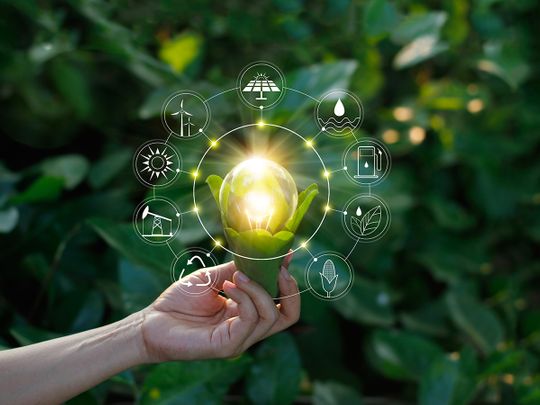
Sustainability is particularly relevant to the United Arab Emirates, a country that has experienced rapid economic growth and modernisation in recent decades. The UAE has become one of the world’s leading oil-producing countries, and its economy has diversified into various sectors, such as tourism, finance, and real estate.
This growth, however, has also led to significant environmental challenges such as carbon emissions and water scarcity. The UAE’s efforts to promote sustainability are vital not only for its future development but also for the world and its efforts to address climate change.
The UAE has set ambitious targets to reduce its carbon footprint, increase renewable energy production, and improve water efficiency. For example, the government aims to generate 50% of its energy from clean sources by 2050, and reduce water consumption by 21% by 2030. The country’s ambitions also include raising awareness of climate change issues through initiatives such as declaring 2023 the Year of Sustainability.
- The UAE’s rise as a global hub for sports diplomacy
- From Mars to the ISS: UAE’s space diplomacy and scientific ambitions
- Etihad Rail: A Key Economic project in UAE’s Vision 2021, Abu Dhabi Economic Vision 2030
As part of the marketing campaign, the government has launched “green” education programs and plans to hold environmental-themed events and exhibitions. They will also encourage partnerships between private and public organisations to promote sustainable practices and encourage innovation in green technology with subsidies and awards.
The 28th United Nations Climate Change Conference, also known as COP28, represents the UAE’s biggest opportunity to showcase its sustainable development achievements and present its plan for global energy transition and decarbonisation.
The event, which will be held November 20 until December 12th at Expo City in Dubai, will bring together experts on climate change and representatives of world governments to discuss strategies for achieving the goals of the Paris Agreement, the climate treaty adopted by 196 countries at COP21 in 2015 and the UN’s 17 Sustainable Development Goals, including Sustainable Cities and Communities, Climate Action, and Responsible Consumption and Production.
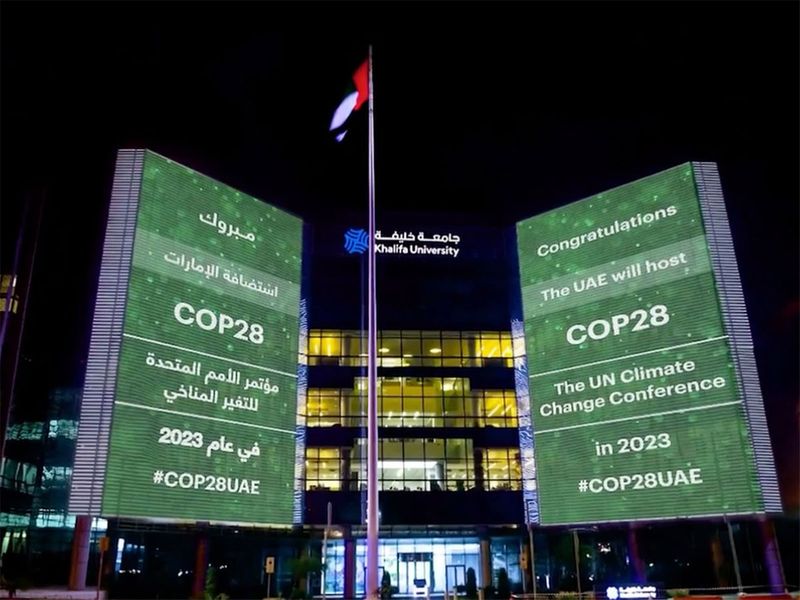
Passing the torch
UAE involves youth, the generation most affected by climate change.
As host, the UAE will emphasise its efforts to transform its economy into one that is driven by clean and renewable energy sources along with technological advancements and climate-friendly solutions. One of the key initiatives in this regard is the UAE’s Smart City Strategy.
Launched in 2014, the policy aims to create innovative cities by leveraging technology and data to improve efficiency, enhance quality of life, and reduce resource consumption.
The development of Masdar City, a zero-carbon city in Abu Dhabi, and the installation of solar panels on public buildings exemplify what the program hopes to achieve. The country has also invested in smart transportation systems, including electric vehicles and intelligent transportation systems, to reduce carbon emissions.
According to the Economist Intelligence Unit Livability Index, Abu Dhabi and Abu Dhabi are among the most liveable cities in the Middle East and Africa, with Abu Dhabi being ranked as the most liveable city in the region for the second year in a row. Sustainability plays a significant role in these rankings, which also consider infrastructure and amenities, transportation systems, health care facilities, and education systems.
Engaging and empowering young people is another plank in the UAE’s platform for achieving long-term sustainability goals. By involving the youth in decision-making, education, and providing support for their initiatives, the UAE seeks to create a generation that is knowledgeable, motivated, and actively involved in shaping a sustainable future. The UAE recognises the importance of engaging young people in such initiatives.
The government has actively encouraged youth participation in environmental and sustainable development programs. Various youth-led organisations, such as the Emirates Youth Council and the Emirates Youth Climate Strategy, have been established to involve young people in decision-making processes related to sustainability.
Government’s focus on sustainability
The government’s focus on sustainability also extends to the aviation industry. Emirates Airlines announced a commitment of $200 million to be dispersed over three years to fund research and development projects aimed at reducing the impact of fossil fuels in commercial aviation. The airline claims that theirs is the largest commitment made by any airline towards sustainability.
The disbursements will be overseen by the Emirates’ Environmental Sustainability Executive Steering Group and supported by technical experts. Emirates intends to invest the money specifically in advanced fuel and energy solutions. Between 2019 and 2022, Etihad Airways reduced their carbon dioxide emissions per revenue tonne kilometre by 26%, according to the company’s annual sustainability report. The airline achieved this by aligning with industry road maps, collaborating with UAE industrial ecosystems, and developing a strategic road map for targets.
The concept of sustainability refers to the ability of current generations to meet their needs without compromising the ability of future generations to meet theirs. Sustainability is about finding a balance between economic, social and environmental concerns, and because what happens to the climate in one part of the world affects other regions it requires global cooperation and youth empowerment.
The UAE has made significant strides in prioritising sustainability and promoting renewable energy. With ambitious targets, collaborative efforts, and hosting major conferences, the UAE is leading by example and inspiring a greener future for generations to come.
Dr Kristian Alexander is a Senior Fellow and the Director of the International Security & Terrorism Program at TRENDS Research & Advisory, Dubai, UAE
More From Op-Eds

UAE: A beacon of global progress and unity
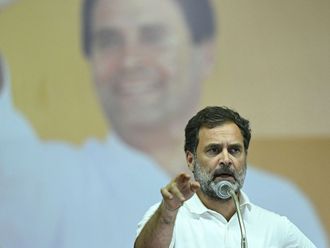
Rise of strong opposition a pivotal moment for India
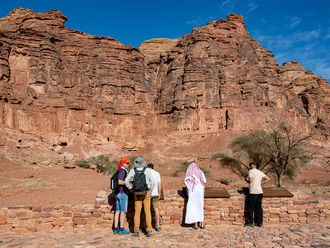
Saudi Arabia’s tourism transformation and complexities
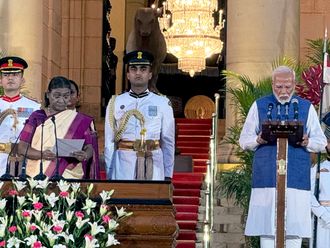
India returns to coalition politics as Modi 3.0 begins

How the BJP went from a bang to a whimper in India

India embraces plurality, rejects one-party dominance

Conflict is part and parcel of all relationships

How Narendra Modi transformed India in 8 years
_resources1_16a4a15e910_small.jpg)
How Indian election results are predicted at Sangam
No survivors in malawi vp's plane crash: president, electrification in accelerated mode in mena region, what will happen to elon musk's $56b tesla pay package, lulu financial holdings celebrates milestone, fun asia network gets audio rights for t20 world cup.

Get Breaking News Alerts From Gulf News
We’ll send you latest news updates through the day. You can manage them any time by clicking on the notification icon.
Green Cities and Urban Sustainability Strategies Essay
- To find inspiration for your paper and overcome writer’s block
- As a source of information (ensure proper referencing)
- As a template for you assignment
Introduction
Built environment, urban agriculture, works cited.
By the beginning of the 21st century, the vast majority of the planet’s population has moved from rural to urban areas around the globe. This gradual phenomenon is associated with the increased urbanization that is still expected to occur worldwide within the next several decades; namely, it is projected that at least two-thirds of the global population will relocate to live in cities in the next three decades, thus creating an inflow of urban population as large as two and a half billion people (Kammen and Sunter 922).
The rapid growth of the urban population has produced a set of negative effects on the cities causing urban decay, the serious strain on infrastructure, and the overconsumption of resources. Moreover, due to the influx of population in urban areas, the adverse environmental outcomes of anthropogenic nature on the areas strengthened. In particular, the increased use of motor vehicles and activity of industries resulted in the production of more emissions of greenhouse gases aggravating the change of climate.
As a result, cities began to require a new approach to development and planning based on a higher level of sustainability. This goal can be achieved through a series of initiatives aimed at the minimization of the negative effects of the growing population density and the maximization of the efficiency of resources and services in the areas. The purpose of this report is to discuss three urban sustainability strategies focusing on transportation means, built environment, and urban agriculture and identify their main challenges and opportunities, best policy instruments, as well as the issues of effectiveness and equity for city sustainability.
The Best Policy Instruments and Infrastructure Investments for Sustainability
In their report, Pucher and Buechler indicated that the surveys of the carbon footprints of the countries of Europe compared to those of the United States showed that the former states seemed to be more productive and successful in their attempts to cut carbon emissions released by motor vehicles (“Walking and Cycling for Healthy Cities” 6-8). However, the authors also specified that a more detailed review of the findings revealed that the major differences in the intensity of the carbon footprints of the two areas were based majorly on the sizes of their territories and the location and planning of urban regions (Pucher and Buechler, “Walking and Cycling for Healthy Cities” 6-7).
In particular, it was noted that in larger territories where people had to travel several kilometers to various destinations, they were more likely to use cars instead of bicycles or walking. Due to the larger territory, the United States tends to have larger and more highly populated cities where people are to travel long distances to get from one location to another; accordingly, the US has more cars that are used more frequently.
In that way, some of the best instruments for the popularization and promotion of cycling and walking is the sustainable planning where the most common destinations and resources are located closer to one another thus reducing the people’s need to use motor vehicles to navigate the urban areas.
The Issues of Effectiveness and a Concern for Equity within the City
It goes without saying that riding a bicycle and walking are known as the healthiest means of transportation that are also safe for the environment because they produce no GHG emissions and also offer a good amount of physical activity to the people who use them. In that way, health benefits are generated both directly and indirectly due to the reduction of emissions and the improvement of the quality of air as well as the facilitation of healthy lifestyle choices (Pucher and Buechler, “Walking and Cycling for Healthy Cities” 2).
However, apart from this aspect, the aforementioned modes of transportation present a series of other advantages for the population of urban areas. In addition to the benefits of having good quality air in urban areas, the increased use of bicycles and walking also contributes to the reduction of noise pollution – another common and quite harmful effect of the use of motor vehicles in highly populated districts.
Moreover, it is also important to notice that the GHG emission produced by cars results in the pollution of water sources that are impacted by the presence of harmful combustion byproducts in the atmosphere. Finally, another obvious factor that contributes to the overall value of the use of bicycles and walking as means of transportation is the reduction of the prevalence of dangerous traffic accidents (Pucher and Buechler, “Walking and Cycling for Healthy Cities” 2).
Also, in regard to financial benefits, walking and bicycle riding are rather cost-effective and economical as they require less costs than cars in terms of personal use, maintenance, and infrastructure arrangements (Pucher and Buechler, “Sustainable Transport in Freiburg: Lessons from Germany’s Environmental Capital” 47).
These modes of transportation are affordable for most people, and this factor contributed to the strong equity of the use of walking and cycling as parts of sustainable development and planning of urban areas. All in all, walking and cycling are unbeatable as the sources of heath, environmental, and economic benefits which makes them a very valuable solution.
The Biggest Challenges and Opportunities
One of the main challenges related to the promotion of the use of bicycles and walking as preferred modes of transportation is based on the implementation of controversial policies to which members of the general public can react negatively (Pucher and Buechler, “Sustainable Transport in Freiburg: Lessons from Germany’s Environmental Capital” 60). Such policies should be implemented gradually and in several stages to ensure a smooth transition.
Also, the promotion of these means of transportation requires the reorganization of infrastructure and resources in a manner that makes this solution appropriate for residents. In well-planned areas, a policy supported by the higher level of government is an excellent long-term opportunity with multiple lasting benefits.
Most of the contemporary large urban areas are unequipped to face and handle the rapid growth of the population in a sustainable manner; in order to increase the sustainability in regard to the improvement of the quality of air and the reduction of GHG emissions, cities are to focus on low carbon and eco-friendly sources of renewable energy one of which is solar energy. Mainstream urban construction oriented at the inclusion of solar panels as a part of the city planning is likely to achieve what can be referred to as zero energy and reduced carbon built environments and homes (Berry and Whaley 91-92).
Infrastructure investments allowing the implementation of solar energy generation for the urban use should be directed at the standardized installation, renovation, and construction of the required photovoltaic equipment in the built environments which may result in flawed delivery and thus call for more costs than planned at first (Berry and Whaley 97). In that way, policy instruments should aim at the optimization of the building design for the appropriate performance levels and be based on thorough evidence and research.
As mentioned previously, the installation and the adjustment of the new standards for solar equipment must match the environments in which it will be used. Inappropriate or flawed research and calculations, as well as the errors during installation, will lead to the ineffective use of equipment and the loss of costs (Berry and Whaley 98).
In that way, it can be said that the effectiveness and equity of this particular policy are highly dependent on the city structures as well as the solar radiation levels in the area and throughout the seasons. For some organizations and buildings this adjustment can be unacceptable or unreasonable due to their location; also, the implementation of this policy will call for the reduction of the number of trees located closely to the populated areas which can negatively impact the quality of air.
The main challenge related to the switch to solar energy is the need for investment in the equipment that may not work properly or not result in the expected benefits due to insufficient research, inappropriate location, seasonal changes in solar radiation levels, and flawed installation and maintenance. However, the opportunity to create zero carbon and zero energy homes is highly beneficial for urban areas, and even if only some of the districts can be equipped with solar panels – it could still be advantageous (Kammen and Sunter 922).
Kirshnan et al. defined urban agriculture as “the growing, processing, and distribution of food and other products through intensive plant cultivation and animal husbandry in and around cities” (325). Best policy instruments for the change aimed at this innovation should aim at the effective and alternative use of land (Wier and Zomer). In addition, Kirshnan et al. recognize food charters as a convenient and effective policy instrument allowing the promotion of the ideas of food security, sustainability, and safety driven by urban agriculture (338-339).
Similarly to the issues faced by innovative planning strategies aiming at the increased use of solar energy in urban areas, urban agriculture also deals with the issues of equity since the relocation of the sources of consumable foods and grown non-food resources to the urban areas is possible in the cities that have the appropriate structures and spaces (Rainwater 46-47). However, the equity is high with this initiative and under the sufficient planning, the areas suitable for urban agriculture can be found if not within, then near the city, thus placing the source of consumable goods closer to the city and minimizing the energy and time spent on the delivery and making the supply chain shorter and more efficient.
The major challenge faced by urban agriculture is linked to the lack of awareness about this practice, and thus the insufficiency of support for its implementation is present (Kirshnan et al. 335-340). In that way, the policies aimed at the introduction of this innovative practice to the urban planning initiatives are to take into consideration the social perception of this change and the potential barriers slowing down its enforcement. The promotion of appropriate values is necessary for the urban authorities to ensure the positive social attitude to this change and a high level of readiness to embrace it and participate in its development.
The major opportunity for the promotion of urban agriculture is the modern social trend for food consciousness, which makes many modern urban citizens more appreciative of a high quality of food, as well as of the chance to learn in detail how it is produced and delivered.
Of the three domains of the sustainable urban planning discussed in this report, the one supporting the healthy and environmentally safe transportation options seems to be the most promising way to reduce the carbon footprint of the city. In addition to the obvious benefits such as the reduction of GHG emissions produced by motor vehicles, the increased use of bicycles in urban areas is also beneficial for the public health and safety because it offers a daily exercise for a better quality of life and safer roads with lower and less dangerous traffic.
Also, in well-populated city centers, this initiative can be gradually introduced due to the dense location of destinations and resources; whereas, in less active urban areas, certain infrastructure adjustments and a more effective placement of common destinations will be needed for the change to work properly (Condon 68).
Condon, Patrick M. Seven Rules for Sustainable Communities . Island Press, n.d.
Berry, Stephen and David Whaley. “The Implications of Mandating Photovoltaics on All New Homes.” Energy Procedia, vol. 83, 2015, pp. 91 – 100.
Kammen, Daniel M. and Deborah A. Sunter. “City-Integrated Renewable Energy for Urban Sustainability.” Urban Planet , vol. 325, no. 6288, 2016, pp. 922-928.
Kirshnan, Sarada et al. “Sustainable Urban Agriculture: A Growing Solution to Urban Food Deserts.” Organic Farming for Sustainable Agriculture , edited by Dilip Nandwani, Springer, 2016, pp. 324-344.
Pucher, John and Ralph Buehler. “Sustainable Transport in Freiburg: Lessons from Germany’s Environmental Capital.” International Journal of Sustainable Transportation , vol. 5, 2011, pp. 43–70.
—. “Walking and Cycling for Healthy Cities.” Built Environment , vol. 36, no. 4, 2010, pp 391-414.
Rainwater, Brooks. Local Leaders in Sustainability. The American Institute of Architects, 2009.
Wier, Emily and Alisa Zomer. “Land Use Planning: The Critical Part of Climate Action Plans that Most Cities Miss.” The Nature of Cities , n.d. Web.
- Transport in China: Cars vs Bicycles and E-Bikes
- New It System: The Shore and More Bicycles Situation
- Cycling Culture in France
- Cityscapes in "Geography of Nowhere" by J. Kunstler
- Land Use Planning: Vallco Mall
- Urban Planning and Growing Population
- The City of Gilbert: General Plan
- Pariser Platz: Architecture and Urbanism of Berlin
- Chicago (A-D)
- Chicago (N-B)
IvyPanda. (2020, November 17). Green Cities and Urban Sustainability Strategies. https://ivypanda.com/essays/green-cities-and-urban-sustainability-strategies/
"Green Cities and Urban Sustainability Strategies." IvyPanda , 17 Nov. 2020, ivypanda.com/essays/green-cities-and-urban-sustainability-strategies/.
IvyPanda . (2020) 'Green Cities and Urban Sustainability Strategies'. 17 November.
IvyPanda . 2020. "Green Cities and Urban Sustainability Strategies." November 17, 2020. https://ivypanda.com/essays/green-cities-and-urban-sustainability-strategies/.
1. IvyPanda . "Green Cities and Urban Sustainability Strategies." November 17, 2020. https://ivypanda.com/essays/green-cities-and-urban-sustainability-strategies/.
Bibliography
IvyPanda . "Green Cities and Urban Sustainability Strategies." November 17, 2020. https://ivypanda.com/essays/green-cities-and-urban-sustainability-strategies/.
- UGREEN Pass
Sustainable Living: Steps to a Greener Future
ESG , Sustainability
0 comments
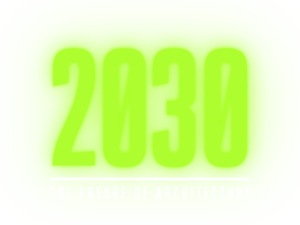
A FREE COURSE TO THE FOREFRONT OF ARCHITECTURE INNOVATION
A FUSION OF SUSTAINABLE DESIGN, HIGH-PERFORMANCE BUILDINGS, AND ARTIFICIAL INTELLIGENCE
JULY 8TH TO 12TH, 2024
ONLINE AND FREE EVENT
By clicking the button, you agree to our Terms of Use and Privacy Policy, including the use of cookies and the sending of communications.
In a world where environmental consciousness is essential, embracing sustainable living has become more crucial than ever. As we tread the path toward a greener future, adopting eco-friendly practices can make a substantial difference. This article will guide you through the essential steps to incorporate sustainable living into your daily life, contributing to a healthier planet for generations to come.
1. Reduce, Reuse, Recycle
The foundation of sustainable living lies in the three R’s: Reduce, Reuse, and Recycle. According to the Environmental Protection Agency (EPA), the United States generated about 292.4 million tons of municipal solid waste in 2018, with only about 69.1 million tons recycled or composted. To make a significant impact, start by minimizing waste by opting for products with minimal packaging. This simple shift can help reduce the staggering amount of waste that ends up in landfills.
Embrace reusable containers, bags, and water bottles to cut down on plastic waste. In the United States alone, over 30 million tons of plastic waste were generated in 2018, with only 8.4% of it being recycled, as reported by the EPA. By choosing reusable options, you can directly contribute to reducing plastic pollution.
Furthermore, make recycling a habit, ensuring that materials get a second life. Recycling one ton of paper, for instance, saves 17 trees, 7,000 gallons of water, and 463 gallons of oil, as per the U.S. Environmental Protection Agency. These statistics emphasize the importance of recycling in conserving valuable resources.
2. Energy Efficiency at Home
Taking steps to improve energy efficiency in your home not only reduces your carbon footprint but also saves you money. The U.S. Department of Energy reports that heating and cooling account for about 48% of energy use in the average American home. By installing energy-efficient appliances, you can significantly cut down on your energy consumption and lower your utility bills.
Consider the impact of lighting as well. LED lighting consumes up to 80 % less energy than traditional incandescent bulbs, and they can last up to 25 times longer. This not only reduces your carbon emissions but also decreases the frequency of bulb replacements, saving you money in the long run.
Additionally, programmable thermostats can help optimize your home’s heating and cooling systems, further reducing energy wastage. Proper insulation is equally critical. Inadequate insulation can lead to substantial energy loss. According to the North American Insulation Manufacturers Association (NAIMA), homeowners can save up to 20 % on heating and cooling costs by properly insulating their homes.
By implementing these energy-efficient strategies, you can both reduce your environmental impact and enjoy cost savings in the process.
3. Sustainable Transportation
Reducing your carbon emissions through sustainable transportation is a significant step in the journey toward a greener future. According to the International Energy Agency (IEA), the transportation sector accounted for approximately 23% of global CO2 emissions in 2019. Here’s how you can make a positive impact:
Choose Alternatives to Driving Alone
Whenever possible, opt for alternative transportation methods. Walking and biking produce zero emissions and promote a healthier lifestyle. In urban areas, public transportation is not only eco-friendly but also reduces traffic congestion.
Carpooling is an effective way to reduce emissions and share the environmental burden. In the United States, the Environmental Protection Agency (EPA) estimates that carpooling can save more than 10,000 pounds (or 4535 kg) of CO2 emissions per person annually. That’s equivalent to planting more than 120 trees per person annually.
Hybrid or Electric Vehicles
If you need to drive, consider investing in a hybrid or electric vehicle (EV). Electric cars, in particular, have zero tailpipe emissions and contribute to a significant reduction in greenhouse gas emissions. In 2020, there were over 10 million electric vehicles on the road globally, according to the International Energy Agency.
4. Conserve Water
Conserving water is a critical aspect of sustainable living, given the global water scarcity challenges. The World Wildlife Fund (WWF) reports that more than 1.1 billion people worldwide lack access to clean and safe water. Here’s how you can contribute to water conservation:
Fix Leaks Promptly
A dripping faucet can waste gallons of water each day. The United States Geological Survey (USGS) estimates that one faucet dripping at a rate of one drop per second can waste more than 3,000 gallons (or more than 11,300 liters, the equivalent to 120 showers) of water per year. Promptly fixing leaks can prevent such wastage.
Install Low-Flow Fixtures
Low-flow fixtures, including faucets, showerheads, and toilets, can significantly reduce water consumption. For instance, low-flow toilets use about 1.6 gallons (or about 6 liters) per flush compared to older models that consume up to 6 gallons.
Rainwater Harvesting
Collecting rainwater for outdoor use can further conserve water. A single inch of rain falling on a 1,000 square foot (approximately 93 square meters) roof can yield over 600 gallons (or over 2,200 liters, the equivalent to 24 showers) of water. By harnessing this resource, you reduce the demand on freshwater sources.
5. Support Sustainable Products
When shopping, your choices can have a substantial impact on the environment and global sustainability efforts. Look for products that are eco-friendly and sustainably sourced:
Certifications Matter
Seek out products with recognized environmental certifications. For example, Fair Trade ensures fair wages and ethical treatment of workers, while Organic certification signifies sustainable and chemical-free farming practices. The Energy Star label indicates energy-efficient appliances.
Eco-Friendly Materials
Many products now use eco-friendly materials like bamboo, recycled plastics, or organic cotton. These materials require fewer resources and reduce environmental impact.
By consciously choosing sustainable transportation options, conserving water, and supporting eco-friendly products, you can contribute to a greener future while making informed decisions that align with global sustainability goals.
6. Reduce Meat Consumption
The meat industry carries a significant environmental footprint. To put it into perspective, according to the Food and Agriculture Organization (FAO), livestock agriculture contributes to approximately 14.5 % of global greenhouse gas emissions. This is more than the emissions produced by all the cars, planes, and trains in the world combined.
But here’s where your plate can make a difference. Consider reducing your meat consumption or exploring plant-based alternatives. Even small changes in your diet can lead to a more sustainable and ethical food choice. For instance, cutting down on meat consumption not only reduces greenhouse gas emissions but also conserves water. The Water Footprint Network reports that it takes about 1,800 gallons of water to produce just one pound of beef (or 0.45 kg). One shower typically uses about 25 gallons of water. Now, picture taking 72 showers – that’s how much water it takes to produce just one pound of beef, as reported by the Water Footprint Network.
7. Create a Sustainable Garden
If you have outdoor space, consider creating a sustainable garden. This isn’t just about aesthetics; it’s about nurturing a healthier planet. Planting native species is a smart choice. These plants are adapted to your region’s climate and require less water and maintenance. By conserving water, you’re helping alleviate the stress on freshwater resources.
Additionally, embrace organic gardening practices to minimize the use of pesticides and synthetic fertilizers. Pesticides can harm beneficial insects and contribute to soil and water pollution. Organic gardening promotes a balanced ecosystem and healthier soil, making your garden a haven for both you and the environment.
8. Eco-Friendly Home Cleaning
Your cleaning routine can also make a positive impact on the environment. Swap out conventional cleaning products for environmentally friendly alternatives. Many eco-friendly cleaning products are effective and safe for both your family and the planet.
Traditional cleaning products often contain chemicals that can be harmful when released into the environment. Phosphates, commonly found in detergents, can lead to water pollution and harm aquatic life. In contrast, eco-friendly cleaning products are formulated to minimize these negative effects while still keeping your home clean and healthy.
9. Reduce, Reuse, Repair
In our quest for sustainability, every action counts. Before you toss out an item, think about the potential for repair and reuse. It’s like giving a second life to things that might otherwise end up in landfills. This simple act not only conserves resources but also helps reduce the environmental impact of producing new items.
For instance, when you fix a broken appliance instead of replacing it, you’re not just saving money; you’re also conserving the raw materials and energy that would have gone into manufacturing a new one. In essence, it’s a small effort with a significant impact.
10. Educate Yourself and Others
Knowledge is a powerful tool in the journey towards sustainability. The more you know, the better equipped you are to make informed decisions. But it doesn’t stop with self-education; sharing your knowledge with friends and family can spark a ripple effect of positive change.
Staying informed about sustainability issues is like having a compass that guides you towards better choices. For instance, you might learn that single-use plastic waste is a global problem. In 2019, global plastic production reached 368 million metric tons, as reported by the World Economic Forum. By sharing this knowledge and encouraging others to adopt sustainable practices, you can collectively work towards protecting our planet. Every small action adds up to a significant impact.
But it doesn’t stop at personal knowledge. Imagine sharing this information with friends and family, sparking discussions and inspiring collective efforts. Through education and advocacy, you can influence others to adopt sustainable practices, creating a spreading that benefits the planet we all call home.
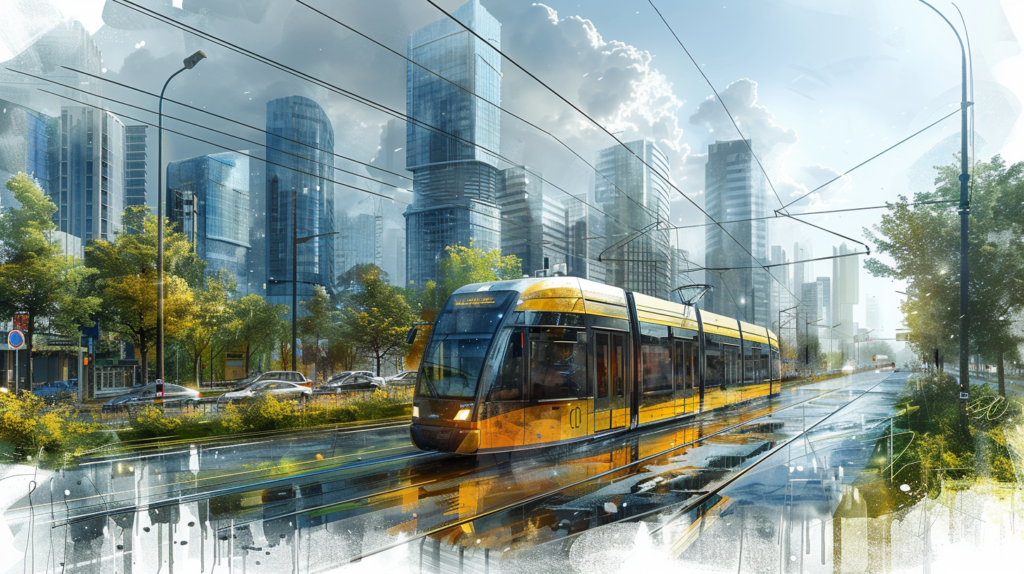
Understanding ESG: Environmental, Social, and Governance Factors
ESG, which stands for Environmental, Social, and Governance, is a framework that evaluates a company’s performance and impact in these three key areas. Let’s break down how ESG relates to the topics we’ve discussed and bring in some real data to illustrate its importance.
1. Environmental (E):
This aspect of ESG focuses on a company’s environmental footprint and commitment to sustainability.
- Reducing Carbon Footprint: ESG considerations often involve assessing a company’s efforts to reduce its carbon emissions. For example, in 2020, Microsoft committed to becoming carbon negative by 2030, aiming to remove more carbon from the atmosphere than it emits.
- Resource Efficiency: ESG also looks at resource use. Walmart, for instance, has committed to zero waste in its operations by 2025 and aims to be powered by 100% renewable energy by 2035.
2. Social (S)
The social aspect of ESG examines a company’s impact on society and its treatment of employees, customers, and communities.
- Workplace Practices: Companies are evaluated on factors such as fair labor practices and diversity and inclusion. For instance, Google publishes annual diversity reports to track progress in creating a more inclusive workplace.
- Community Engagement: ESG also considers a company’s involvement in the communities where it operates. Starbucks, for example, has set a goal to donate 100 million coffee trees to coffee farmers by 2025, helping to support sustainable livelihoods.
3. Governance (G)
Governance relates to a company’s leadership, ethics, and transparency.
- Ethical Leadership: Companies are assessed for ethical leadership and responsible decision-making. Apple, for example, has stringent supplier responsibility standards to ensure ethical practices throughout its supply chain.
- Transparency and Reporting: ESG requires transparency in reporting. Johnson & Johnson, a pharmaceutical giant, provides comprehensive sustainability reports that detail its progress and goals in various ESG areas.
ESG is increasingly important for businesses, investors, and consumers alike. It’s not just about being socially responsible; it also makes good business sense. Companies that embrace ESG principles are often better positioned to navigate risks, attract investors, and build trust with customers. At UGREEN, we understand the significance of ESG in today’s world. Explore our Sustainability Consulting services and Life Cycle Assessment post to see how we can help you incorporate ESG into your sustainability strategy and accelerate sustainability worldwide.
In Conclusion: Building a Greener Future Through Sustainable Living
In summary, sustainable living is far more than just a personal choice; it’s a collective commitment to the well-being of our planet. By adopting the steps outlined in this guide and seamlessly integrating sustainable practices into your daily life, you become a crucial player in the global effort to create a greener future.
Embrace Sustainability Today, Transform Tomorrow
To emphasize the significance of this commitment, let’s turn to some real data:
- According to the United Nations, the world population is expected to reach 9.7 billion by 2050. This population growth places tremendous pressure on our planet’s resources. Sustainable living practices are essential to ensure a better quality of life for all while safeguarding the environment.
- The World Wildlife Fund (WWF) reports that humanity’s ecological footprint — the demand we place on the Earth’s resources — currently exceeds the planet’s capacity to regenerate. This overshoot leads to environmental degradation and threatens biodiversity.
Your Role in the Grand Scheme of Sustainability
Your role in this grand scheme is not insignificant. By making conscious choices, such as reducing meat consumption, conserving water, and supporting eco-friendly products, you directly contribute to positive change. It’s not just about the environment; it’s also about preserving a healthy and prosperous future for generations to come.
Start Your Sustainable Journey Now
To embark on your sustainable journey with guidance and expertise, explore our Sustainability Consulting services . These services offer personalized strategies to accelerate your sustainability efforts on a larger scale.
Additionally, delve into Life Cycle Assessment to gain insights into the environmental impacts of your products and processes, enabling more informed and sustainable decision-making.
Remember, every seemingly small effort counts when striving for a more sustainable and eco-conscious lifestyle. Together, we can create a world where sustainability thrives, and the planet flourishes. Start your sustainable journey today and be part of the positive change the world urgently needs.
If you watn o learn about our consultancies in Portuguese language, click here.
Want to Develop An LCA?
Develop your product life cycle assessment and position your brand toward a sustainable future., you may also like, eco-logical design: a comprehensive look at ecological architecture today, tadao ando: blending nature with concrete elegance, future-proofing structures: advanced techniques in earthquake-resistant design, thomas heatherwick: pioneering human-centric design in architecture and urban planning.
Session expired
Please log in again. The login page will open in a new tab. After logging in you can close it and return to this page.
Get Your Free UGreen EBook Pack Now!

We're offering, for a limited time, an exclusive UGREEN EBook Pack filled with valuable insights on architecture, interiors, and sustainable construction strategies — all in one unique bundle.
Simply enter your email to gain instant access to this incredible resource while it's available for free.

Essay on Go Green Save Future

More and more people are thinking about the environmental issues and ecological condition of Earth nowadays. Why has this problem become so relevant? What should we do to save our future? In my opinion, people have understood that their irresponsibility causes harm to the natural environment. Our planet suffers from numerous problems, which have been caused by the results of the excessive anthropogenic activity. The entire planet suffers from pollution, global warming, deforestation, extinction of biological species, etc. These problems are extremely relevant and require rapid and intensive solutions. It is possible to defeat these problems if the entire humanity changes its approach towards nature, natural resources and the value of nature for its wellbeing. In simple words, people should go green to save Earth.
Why should we take efforts now in order to save Earth in future?
Very few people understand that it is important to change their lifestyle now in order to see the results of these changes in a few decades. Doubtless, you will not grow a big forest in a year. You can plant a small tree but it will grow to its proper height only in ten or fifteen years. To my mind, this activity resembles investment into a small firm. In a few years, the firm develops into a big company, which will provide you with the solid profit. Consequently, it is not right to say that the idea of going green is useless. When you do not see the results of your activity now, it does not mean that you will not see them in ten years.
Consider future generation
Furthermore, we must not be selfish. It is important to think about the wellbeing of our children and grandchildren. We are responsible for the natural environment and problems, which will become the burden for our children.
I know that many people do not care about the condition of Earth after their death. They say that it is the headache of our future generations. I suppose, it is the main problem. People do not care about future and they do not appreciate what they have.
This approach is caused by greediness and consumerism. People want more money and material values in order to satisfy their needs. They are ready to exhaust the world they live in. They cut down forests, kill animals, birds and fish and pollute rivers, lakes, seas and oceans. They care about their profit and nothing more. No wonder, people open new and new plants, factories and power stations, which cause harm to the natural environment but provide them with money.
It looks ridiculous when people are ready to destroy forests and pollute rivers in order to gain profit. People do not appreciate fresh air and water, though they cannot survive a minute without them. They are ready to live in the unhealthy, terribly-looking and polluted environment in order to receive more money. Finally, they will have to pay for their treatment at a hospital, because they breathe in polluted air and consume contaminated food and water.
There are a number of companies who are already into having a ‘greener’ business system. An example is Movegreen, who are using an eco-conscious approach for doing business. These specialized movers in Orange County are providing excellent services for anyone wanting to move in Southern California.
How can we save our planet from the results of our harmful activity?
To begin with, we should reduce pollution, because it the cause of numerous problems. We must not litter in the street, parks and forests. We should recycle wastes in order to save our priceless natural recourses and we should always responsibly recycle electronics and e-waste , not just dump them in the landfills.
We should use public transport more frequently, because it does not release numerous harmful gases, which cause greenhouse effect and global warming. Next, entrepreneurs should use special filters at plants, factories and power stations in order to reduce the amount of poisonous emissions into the air and water. Then, people should stop cutting down forests, because they are the lungs of Earth.
Moreover, every forest is a home for thousands of animals, birds and insects, which improve the balance of ecosystems.
In conclusion, our unwise and extensive activity causes harm to the natural environment. We lose priceless natural resources, fresh air, water, forests, animals, birds, fish, insects, etc. People should change their lifestyle rapidly in order to stop deforestation, global warming, pollution and other problems, which can destroy the life on the planet. We ought to go green in order to save the life of future generations.
This short essay on such a popular topic is provided by http://smartwritingservice.com writing company which produces custom written essays.
18 Comments
Informative n comprehensive essay .
it is a very good paragraph.it teaches children good how to keep nature good.i liked it so much.i think you are a very good teacher.so u teach good things to every body.thank you!!!!!!!!!!!!!!
I like this eassy very much thank you
Very informative!!!
This essay helps alto to teach my student in better manner.
A good feedback of modi’s mission
It is very helpful for me
This information is very important for me
very useful
thanks for this
It is very innovative and useful for me.
Very persuasive and appealing to the readers!
I have got every point. Very precious
I love this essay as it is the need of todays world
Very interesting.#shyam
I really enjoyed reading these and they helped me in writing my own essay, and Im in highschool! Thanks!
They are ready to exhaust the world they live in. They cut down forests, kill animals, birds and fish and pollute rivers, lakes, seas and oceans. They care about their profit and nothing more. No wonder, people open new and new plants, factories and power stations, which cause harm to the natural environment but provide them with money. It looks ridiculous when people are ready to destroy forests and pollute rivers in order to gain profit. People do not appreciate fresh air and water, though they cannot survive a minute without them.
You must log in to post a comment.
This site uses Akismet to reduce spam. Learn how your comment data is processed .
You Might Also Like

With Long-Term Contracts and PPAs, Axpo Secures the Future of the Energy Transition

Sustainable Choices- Exploring Eco-Friendly Film Packaging Options

Going Green: 6 Eco-friendly and Sustainable Pest Control Methods for Home Use

Unrivaled Versatility: 5 Creative Ways To Use an Ottoman

How To Make Your Real Estate Development More Sustainable

The Role of ESG in Driving Sustainable Innovation and Growth
- Green Travel
- Green Waste
- Green Energy
- Green Finance
- Green Products
- Green Technology

Strategies to promote cleaner, greener and a bluer future Essay
Essay – strategies to promote cleaner, greener and a bluer future.
Strategies to promote cleaner, greener and a bluer future Essay: A greener, cleaner future reflects overall development in our environment with sufficient resources, sustainability and low carbon footprint. In the greener earth employment will be created with both private and public sector investment with improve economic activities and innovative infrastructure. When carbon emission is controlled and the ecological balance is maintained people learn to use resources wisely. The government should invest more in sustainable facilities to support logical expenditure of public services. It should take initiatives for reforming policies, taxation and regulations where people will be more aware and change their activities. The United Nations environment program create a development path where people will be benefited in their livelihood by depending on natural resources. The greener future aims at creating new form of investment, infrastructure, employment, skills, and technology and positive effects on environment. If the policies become improved the other areas will be followed by people systematically. This essay will shed light on the ongoing strategies of making our earth suitable place for cleaner, greener and bluer future.
Sustainable economy:
Using renewable energy and recycle process:.
The big issue we are facing in environment is climate and change and global warming. Burning of fossil fuels and increased greenhouse gas emissions are the reasons behind imbalanced ecological balance and environment pollution. So, we must move forward in being diversify usage of energy sources. We should opt for renewable energy sources like solar energy, wind energy, biomass, geothermal energy, hydroelectric power etc. which does not impact our environment with greenhouse gases. The government of developed countries has already invested in transforming energy resources for electricity and vehicles to renewable energy. Public transport, infrastructure, household purposes etc. will be run by renewable energy soon. Even manufacturing and other industries are shifting to renewable energy for protecting the environment.
Conserve water resources:
Reduce carbon footprint:.
Forests are the ideal filters which absorb carbon from the environment during their food making process and maintain the balance. To reduce carbon footprint from the environment we should be more aware about cutting trees unplanned ways. The government should take strict initiative and arrange programs where people will take active parts in planting new trees. When the world will be green and pure the environmental balance will be fixed eventually.
Using sustainable products:
Conclusion:, leave a reply cancel reply, we have a strong team of experienced teachers who are here to solve all your exam preparation doubts, first phase of indian nationalist movement class 10 mcq, nios class 10 social science chapter 2 solution – medieval world, nios class 10 social science chapter 1 solution – ancient world, biral (বিড়াল) class 11 mcq questions answers for semester 1.

IMAGES
VIDEO
COMMENTS
The statistics are sobering—with 9.7 billion people on the planet by 2050, we can expect a 54 percent increase in global food demand and 56 percent increase in energy demand. While meetings these growing demands and achieving sustainability is possible, it is helpful to scrutinize where the status quo will get us.
10 bold ideas driving a sustainable future. From powering the planet with untapped clean energy to making climate action go viral, these 10 transformative ideas from the intersection of tech and sustainability are driving positive change — and building a greener future for generations to come.
The nexus between technology and sustainability stands as a beacon of hope in our quest for a greener future. Innovations such as renewable energy sources, smart grids, and energy-eficient technologies are pivotal in mitigating the impact of climate change. The burgeoning field of clean energy, marked by solar and wind power breakthroughs, is ...
Essay on Sustainable Development: Samples in 250, 300 and 500 Words. Team Leverage Edu. Updated on. Nov 18, 2023. 7 minute read. On 3rd August 2023, the Indian Government released its Net zero emissions target policy to reduce its carbon footprints. To achieve the sustainable development goals (SDG), as specified by the UN, India is determined ...
The Simpler Way to a Greener Future. DEVELOPMENT & SOCIETY : Energy, Climate Change, Environment. 2012•04•02 Brendan F.D. Barrett Osaka University. Photo: Sean Wood. I have been thinking a lot over the past few years about what I can do to reduce my ecological footprint. It is really not acceptable to ask others to make behavioural changes ...
In an era marked by growing environmental concerns, the importance of sustainability has never been more evident. As the human footprint on the planet continues to expand, there is a pressing need to adopt practices that mitigate environmental degradation and promote a healthier planet for current and future generations.
A BLUEPRINT FOR A GREEN FUTURE 3 UK Government commitments under the 25-Year Environment Plan. • Provide government leadership to remove the barriers to green innovation and adoption, for instance by supporting brokering organisations to connect businesses in the circular economy, based on cutting-edge scientific research.
Environmental Issues Essay: Exploring Sustainable Solutions for a Greener Future. In our rapidly evolving world, addressing our pressing environmental challenges has become imperative. This essay aims to delve into the depths of these environmental issues, highlighting their significance, and embark on a journey to explore sustainable solutions ...
The concept of Green Urbanism connects sustainable development techniques with urban planning to preserve future resources Greening Our Cities: Sustainable Urbanism for a Greener Future: A Culmination of Selected Research Papers from the International Conferences on Green Urbanism (GU) - 6th edition and Urban Regeneration and Sustainability ...
Beyond the individual. Studies and online trends have unequivocally shown that Gen-Z are the most concerned for the planet's green future and usually succeed in encouraging others to consider sustainability when carrying out buying decisions. This can be seen in a survey by First Insight and the Baker Retailing Center at the Wharton School of the University of Pennsylvani a which found that ...
Future of Sustainability: Creating a Greener Future. August 30, 2022. For more than 50 years, people's ecological footprint has exceeded what the planet can regenerate. Humans use 1.56 times more than Earth's biocapacity, according to a recent World Wildlife Fund report. That means it would take Earth about a year and a half to restore what ...
The concept of 'energy transition' embodies a strategic shift from conventional fossil fuels to cleaner and more sustainable energy sources. It represents a visionary pathway toward a future where humanity can thrive without compromising the delicate balance of the planet's ecosystems. This transformative journey acknowledges the imperative of reducing carbon dioxide emissions ...
Juniper can help create a greener future for your school . Juniper is here to help your school identify areas of strength and improvement relating to your sustainability practices. We will act as your 'critical friend', considering government climate and change strategy while tailoring our review to your school's requirements. Our ...
Introduction: In an era marked by environmental challenges and a growing awareness of the impact of human activities on the planet, the pursuit of sustainable practices has become imperative for shaping a greener future. This essay explores the concept of sustainability, examining various initiatives and practices that contribute to environmental conservation, promote eco-friendly lifestyles ...
Sustainable Development for a greener future Essay : Sustainable development refers to development that is capable of meeting the needs of the present generation without compromising the ability of future generations to get their own needs met. In other words, sustainable development goals popularly known as the global goals were adopted by the United Nations as a ubiquitous call to eradicate ...
Greener Future. Good Essays. 1074 Words. 5 Pages. 7 Works Cited. Open Document. In an age where each new day is another countdown toward global warming, recycling may be our last hope. Since the beginning of mankind, we as consumers have always relied on the earth for its natural resources as we do in our non-biodegradable products now.
Innovations for a Sustainable Future: One of the most exciting aspects of sustainability is the ongoing wave of innovation and technological advancements aimed at creating a greener future. From renewable energy sources like solar and wind power to smart grids and energy-efficient appliances, these innovations hold immense potential for reducing our carbon footprint.
Between 2019 and 2022, Etihad Airways reduced their carbon dioxide emissions per revenue tonne kilometre by 26%, according to the company's annual sustainability report. The airline achieved ...
The purpose of this report is to discuss three urban sustainability strategies focusing on transportation means, built environment, and urban agriculture and identify their main challenges and opportunities, best policy instruments, as well as the issues of effectiveness and equity for city sustainability.
This article will guide you through the essential steps to incorporate sustainable living into your daily life, contributing to a healthier planet for generations to come. 1. Reduce, Reuse, Recycle. The foundation of sustainable living lies in the three R's: Reduce, Reuse, and Recycle.
We lose priceless natural resources, fresh air, water, forests, animals, birds, fish, insects, etc. People should change their lifestyle rapidly in order to stop deforestation, global warming, pollution and other problems, which can destroy the life on the planet. We ought to go green in order to save the life of future generations.
This essay will shed light on the ongoing strategies of making our earth suitable place for cleaner, greener and bluer future. Contents. Essay - Strategies to promote cleaner, greener and a bluer future Sustainable economy: Using renewable energy and recycle process: Conserve water resources: Reduce carbon footprint: Using sustainable ...
The task ahead is daunting. The World Green Building Council estimates that every building on the planet must be 'net-zero carbon' by 2050 to keep global warming below 1.5°C - yet currently less than 1% of the global building stock meets this standard. Transforming the way we design, construct and operate buildings cannot be left to any one industry.